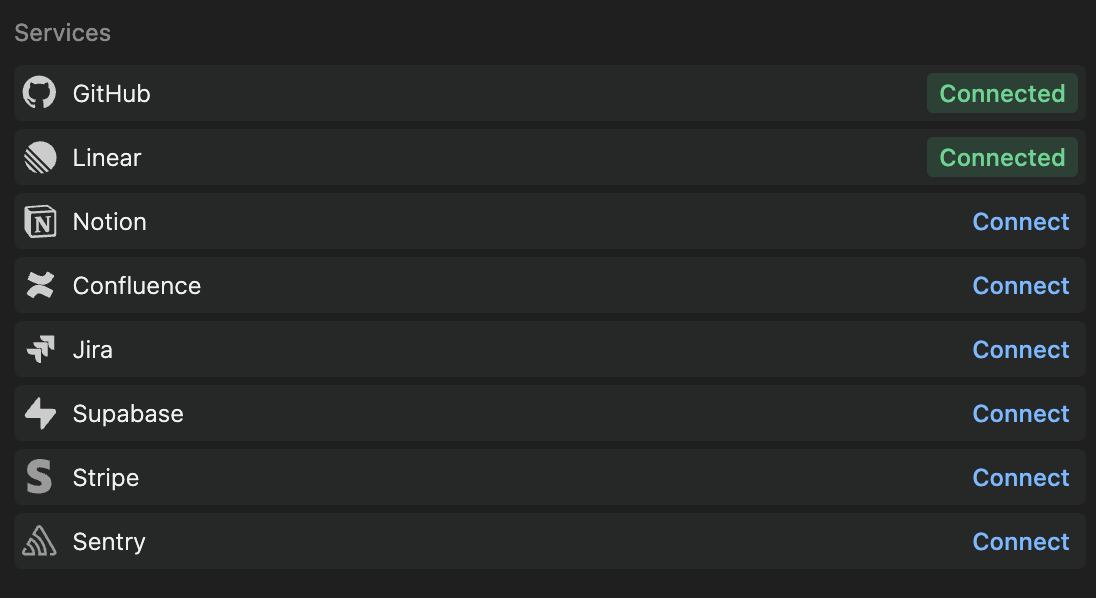 You'll be redirected to authorize the integration with the appropriate service. After authorization, the integration will be available for use with Augment Agent.
## MCP Integrations
In addition to native integrations, Auggie can also access external systems through Model Context Protocol (MCP) servers. MCP servers enable Auggie to interact with external tools and services through a standardized protocol, such as accessing databases, running browser automation, sending messages to Slack, or integrating with APIs.
### Configure MCP via settings.json
You can persist MCP servers in the Augment settings file `~/.augment/settings.json`, which will initialize on startup and can be checked with `/mcp-status`.
```json theme={null}
{
"mcpServers": {
"context7": {
"type": "http",
"url": "https://mcp.context7.com/mcp",
"headers": {
"CONTEXT7_API_KEY": "YOUR_API_KEY"
}
},
"weather": {
"type": "sse",
"url": "https://weather-mcp.example.com/v1",
"headers": {
"X-API-Key": "your_weather_api_key",
"Content-Type": "application/json"
}
},
"renderMCP": {
"type": "http",
"url": "https://mcp.render.com/mcp",
"headers": {
"Authorization": "Bearer
You'll be redirected to authorize the integration with the appropriate service. After authorization, the integration will be available for use with Augment Agent.
## MCP Integrations
In addition to native integrations, Auggie can also access external systems through Model Context Protocol (MCP) servers. MCP servers enable Auggie to interact with external tools and services through a standardized protocol, such as accessing databases, running browser automation, sending messages to Slack, or integrating with APIs.
### Configure MCP via settings.json
You can persist MCP servers in the Augment settings file `~/.augment/settings.json`, which will initialize on startup and can be checked with `/mcp-status`.
```json theme={null}
{
"mcpServers": {
"context7": {
"type": "http",
"url": "https://mcp.context7.com/mcp",
"headers": {
"CONTEXT7_API_KEY": "YOUR_API_KEY"
}
},
"weather": {
"type": "sse",
"url": "https://weather-mcp.example.com/v1",
"headers": {
"X-API-Key": "your_weather_api_key",
"Content-Type": "application/json"
}
},
"renderMCP": {
"type": "http",
"url": "https://mcp.render.com/mcp",
"headers": {
"Authorization": "Bearer
Availability
{tags.map(tag =>
{tag}
)}
;
};
 Options include:
* **Open in Agent Session**: For VS Code only, allows you to copy the prompt and start a new thread inside the Augment Code extension
* **Copy to Clipboard**: Allows you to paste the prompt into your preferred environment, e.g. Auggie CLI, Augment Code for JetBrains, etc.
Options include:
* **Open in Agent Session**: For VS Code only, allows you to copy the prompt and start a new thread inside the Augment Code extension
* **Copy to Clipboard**: Allows you to paste the prompt into your preferred environment, e.g. Auggie CLI, Augment Code for JetBrains, etc.
 ***
## Best Practices
**Review the Fix**: Always review the changes proposed by Agent before accepting them. While Agent has full context, you should verify the fix aligns with your intent.
**Test the Changes**: Run your tests after applying the fix to ensure the issue is resolved and no new issues are introduced.
**Update the PR**: After pushing your fix, you can reply to the Code Review comment to indicate you've addressed the issue.
**Request Follow-up Review**: If you make significant changes, consider requesting another review by commenting `auggie review` on your PR.
# Adding Context with MCP
Source: https://docs.augmentcode.com/codereview/mcp-context
Connect Augment Code Review to external context sources through Model Context Protocol.
## Configuring Model Context Protocol (MCP) Servers
Administrators can connect Augment Code Review to external context sources through Model Context Protocol (MCP). MCP servers provide additional context to the code review agent, such as access to documentation, APIs, databases, or other external systems that can help improve review quality.
To configure MCP servers, visit [MCP for Code Review](https://app.augmentcode.com/settings/code-review/mcp).
### Types of MCP Servers
Augment Code Review supports both remote and local MCP servers:
* **Remote MCP servers** run remotely and are hosted by providers. Once you add a remote MCP server, you may need to complete an OAuth flow to authenticate before it can be used by the code review agent.
* **Local MCP servers** run in their own environment within the code review agent's workspace. You can specify environment variables for local servers when adding them. Environment variables are write-only and can only be overwritten or removed (not viewed) after the server has been added.
### Adding MCP Servers
There are three ways to add MCP servers to Code Review:
#### 1. Add Local MCP Server (+ MCP)
To add a local MCP server:
1. Navigate to [MCP for Code Review](https://app.augmentcode.com/settings/code-review/mcp)
2. Click **+ MCP** to add a local server
3. Enter the following information:
* **Name**: A descriptive name for your MCP server
* **Command**: The executable command to run the server
* **Arguments**: Command-line arguments (optional)
4. Add environment variables if needed:
* Click **+ Environment Variable**
* Enter the variable name and value
* Repeat for additional variables
5. Click **Add Server** to save
***
## Best Practices
**Review the Fix**: Always review the changes proposed by Agent before accepting them. While Agent has full context, you should verify the fix aligns with your intent.
**Test the Changes**: Run your tests after applying the fix to ensure the issue is resolved and no new issues are introduced.
**Update the PR**: After pushing your fix, you can reply to the Code Review comment to indicate you've addressed the issue.
**Request Follow-up Review**: If you make significant changes, consider requesting another review by commenting `auggie review` on your PR.
# Adding Context with MCP
Source: https://docs.augmentcode.com/codereview/mcp-context
Connect Augment Code Review to external context sources through Model Context Protocol.
## Configuring Model Context Protocol (MCP) Servers
Administrators can connect Augment Code Review to external context sources through Model Context Protocol (MCP). MCP servers provide additional context to the code review agent, such as access to documentation, APIs, databases, or other external systems that can help improve review quality.
To configure MCP servers, visit [MCP for Code Review](https://app.augmentcode.com/settings/code-review/mcp).
### Types of MCP Servers
Augment Code Review supports both remote and local MCP servers:
* **Remote MCP servers** run remotely and are hosted by providers. Once you add a remote MCP server, you may need to complete an OAuth flow to authenticate before it can be used by the code review agent.
* **Local MCP servers** run in their own environment within the code review agent's workspace. You can specify environment variables for local servers when adding them. Environment variables are write-only and can only be overwritten or removed (not viewed) after the server has been added.
### Adding MCP Servers
There are three ways to add MCP servers to Code Review:
#### 1. Add Local MCP Server (+ MCP)
To add a local MCP server:
1. Navigate to [MCP for Code Review](https://app.augmentcode.com/settings/code-review/mcp)
2. Click **+ MCP** to add a local server
3. Enter the following information:
* **Name**: A descriptive name for your MCP server
* **Command**: The executable command to run the server
* **Arguments**: Command-line arguments (optional)
4. Add environment variables if needed:
* Click **+ Environment Variable**
* Enter the variable name and value
* Repeat for additional variables
5. Click **Add Server** to save
 # Adding Review Guidelines
Source: https://docs.augmentcode.com/codereview/review-guidelines
Configure custom guidelines to help Augment Code Review focus on specific areas and domain knowledge.
## Tell Augment Code Review to check specific areas with guidelines
Some domain knowledge cannot be inferred from code alone. Tell Augment Code Review exactly what to check by adding custom guidelines. Guidelines are most relevant for repositories that contain multiple distinct domains and should be captured as custom review guidelines. Tell Augment Code Review to check specific areas like security vulnerabilities or inside particular directories when relevant. Augment Code Review allows you to outline these special guidelines per repository. Describe any areas of focus using a yaml file entitled code\_review\_guidelines.yaml inside the .augment folder at the repository root:
`
# Adding Review Guidelines
Source: https://docs.augmentcode.com/codereview/review-guidelines
Configure custom guidelines to help Augment Code Review focus on specific areas and domain knowledge.
## Tell Augment Code Review to check specific areas with guidelines
Some domain knowledge cannot be inferred from code alone. Tell Augment Code Review exactly what to check by adding custom guidelines. Guidelines are most relevant for repositories that contain multiple distinct domains and should be captured as custom review guidelines. Tell Augment Code Review to check specific areas like security vulnerabilities or inside particular directories when relevant. Augment Code Review allows you to outline these special guidelines per repository. Describe any areas of focus using a yaml file entitled code\_review\_guidelines.yaml inside the .augment folder at the repository root:
`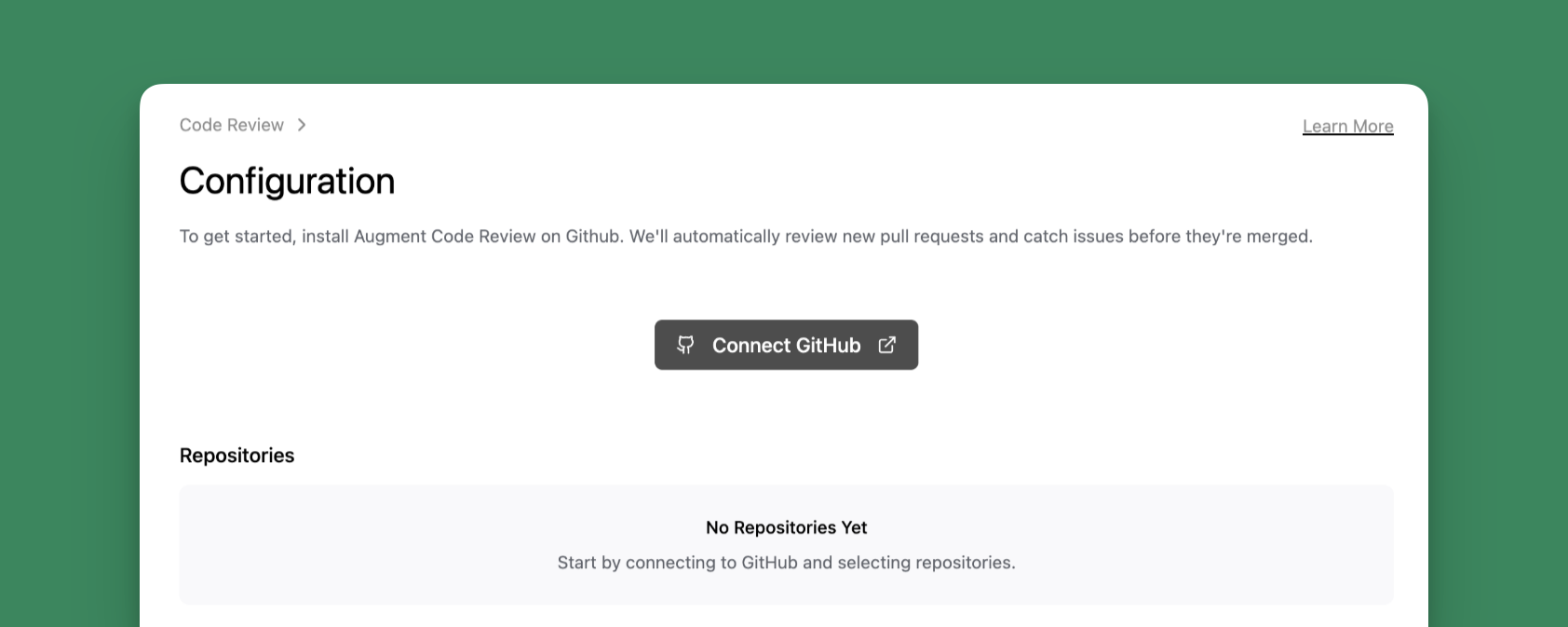 If your firewall configuration, allowlist or network policy requires a static IP for this integration, please refer to our [static IP address](https://docs.augmentcode.com/setup-augment/static-ip-support#allow-augment-traffic-from-static-ips) documentation.
If your firewall configuration, allowlist or network policy requires a static IP for this integration, please refer to our [static IP address](https://docs.augmentcode.com/setup-augment/static-ip-support#allow-augment-traffic-from-static-ips) documentation.
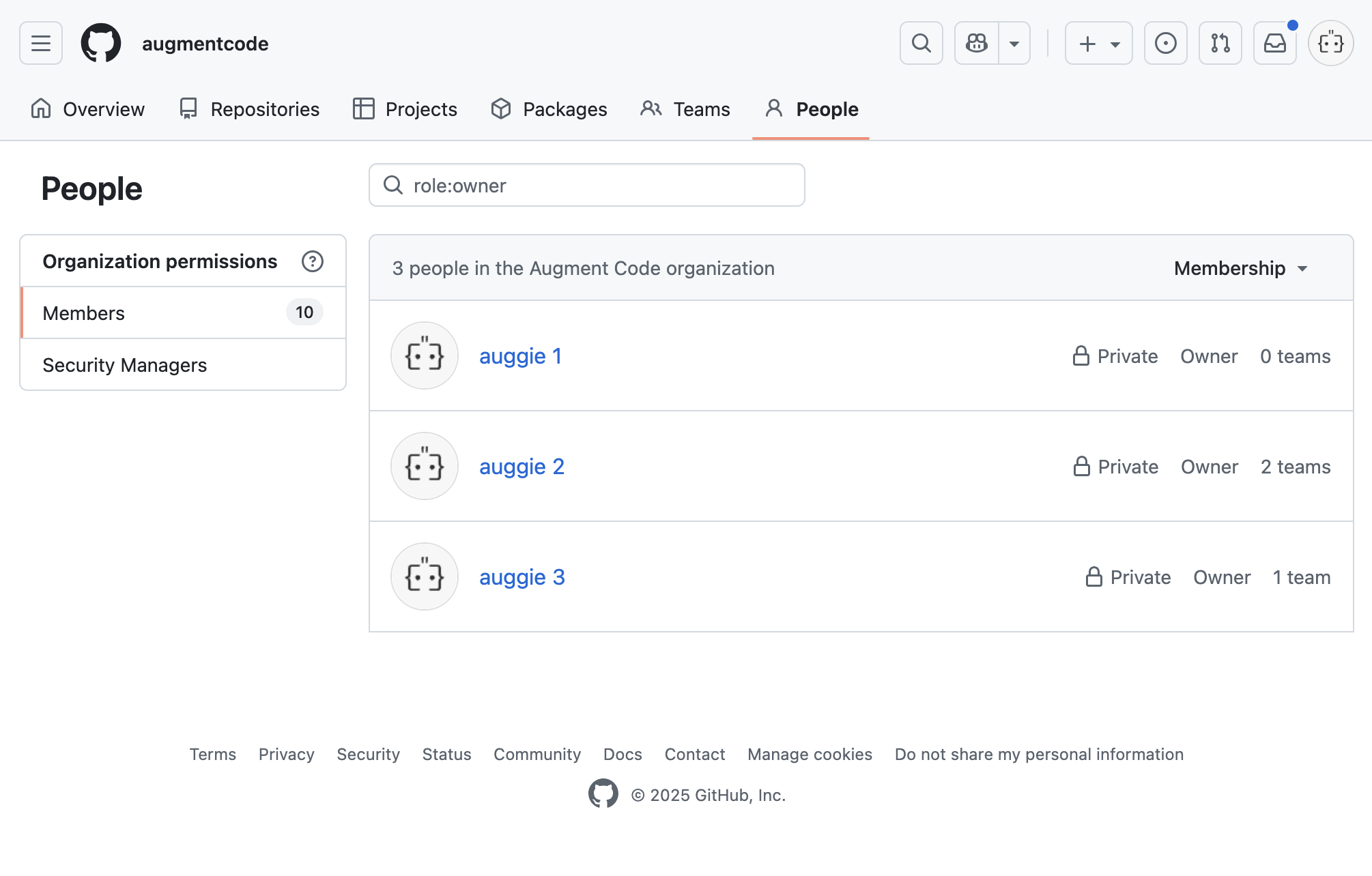
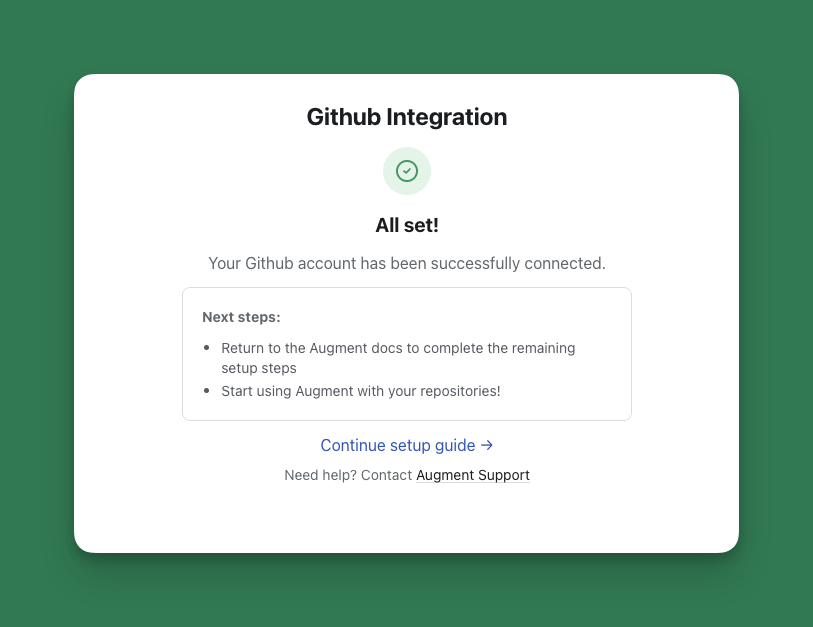 ### Permissions requested by the Augment GitHub App:
* Contents, read-only: Clone repositories
* Pull Requests, read and write: Read pull requests and post comments to pull requests
* Issues, read-only: Read top-level PRs / Issues
* Organization Members, read-only: Read members of an organization, to distinguish internal and external users and their access levels to Augment features
Organization owners and repository admins can install the app directly; others will need owner approval. See [GitHub documentation](https://docs.github.com/en/apps/using-github-apps/installing-a-github-app-from-a-third-party) for details. If your organization uses [Augment for Slack,](https://docs.augmentcode.com/setup-augment/install-slack-app) the same selections will apply to both Augment for Slack and Augment Code Review.
### Permissions requested by the Augment GitHub App:
* Contents, read-only: Clone repositories
* Pull Requests, read and write: Read pull requests and post comments to pull requests
* Issues, read-only: Read top-level PRs / Issues
* Organization Members, read-only: Read members of an organization, to distinguish internal and external users and their access levels to Augment features
Organization owners and repository admins can install the app directly; others will need owner approval. See [GitHub documentation](https://docs.github.com/en/apps/using-github-apps/installing-a-github-app-from-a-third-party) for details. If your organization uses [Augment for Slack,](https://docs.augmentcode.com/setup-augment/install-slack-app) the same selections will apply to both Augment for Slack and Augment Code Review.
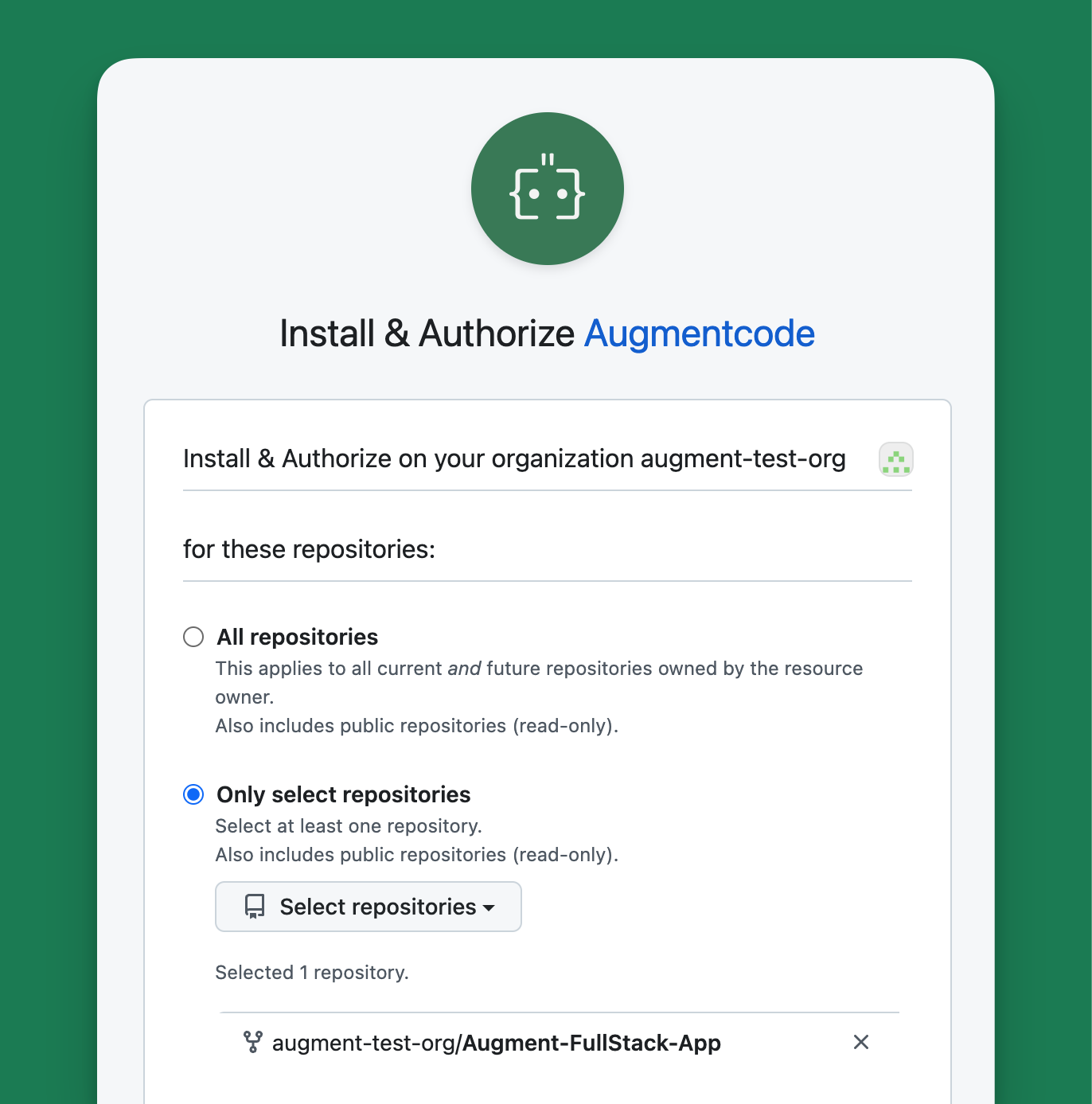 You can modify repository access anytime in the Augment GitHub App settings.
### Configuring Triggers Per Repository
As the Administrator, you control when Augment Code Review triggers via [Settings](https://app.augmentcode.com/settings/code-review). Look for "Set Review Trigger" to the right of the repository name.
* **Automatic**: Augment Code Review will automatically review and post a comment as soon as the PR is opened for review in GitHub. Use it when your teams want immediate feedback on all pull requests.
* **Manual Command**: Augment Code Review is only triggered when someone comments on the PR with any of the following: `auggie review`, `augment review`, or `augmentcode review` on GitHub. Use it when you want full control over when a review happens.
* **Disabled**: Augment Code Review will not run on the repository.
You can modify repository access anytime in the Augment GitHub App settings.
### Configuring Triggers Per Repository
As the Administrator, you control when Augment Code Review triggers via [Settings](https://app.augmentcode.com/settings/code-review). Look for "Set Review Trigger" to the right of the repository name.
* **Automatic**: Augment Code Review will automatically review and post a comment as soon as the PR is opened for review in GitHub. Use it when your teams want immediate feedback on all pull requests.
* **Manual Command**: Augment Code Review is only triggered when someone comments on the PR with any of the following: `auggie review`, `augment review`, or `augmentcode review` on GitHub. Use it when you want full control over when a review happens.
* **Disabled**: Augment Code Review will not run on the repository.
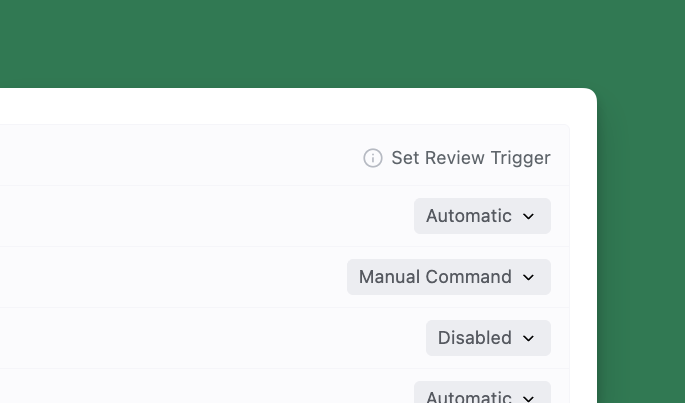 If the repo is set to "Automatic" or "Manual Command", to run additional rounds of reviews on a subsequent commit of any PR, you can use the same manual trigger keywords (`auggie review`, `augment review`, or `augmentcode review`).
On public repositories, reviews are only triggered for PRs whose authors are members of the GitHub organization, outside collaborators to the organization or repository, or contributors to that repository.
## Next Steps
Now that you've completed the basic setup, explore these additional features to get the most out of Augment Code Review:
If the repo is set to "Automatic" or "Manual Command", to run additional rounds of reviews on a subsequent commit of any PR, you can use the same manual trigger keywords (`auggie review`, `augment review`, or `augmentcode review`).
On public repositories, reviews are only triggered for PRs whose authors are members of the GitHub organization, outside collaborators to the organization or repository, or contributors to that repository.
## Next Steps
Now that you've completed the basic setup, explore these additional features to get the most out of Augment Code Review:
 If your firewall configuration, allowlist or network policy requires a static IP for this integration, please refer to our [static IP address](https://docs.augmentcode.com/setup-augment/static-ip-support#allow-augment-traffic-from-static-ips) documentation.
If your firewall configuration, allowlist or network policy requires a static IP for this integration, please refer to our [static IP address](https://docs.augmentcode.com/setup-augment/static-ip-support#allow-augment-traffic-from-static-ips) documentation.

 ### Permissions requested by the Augment GitHub App:
* Contents, read-only: Clone repositories
* Pull Requests, read and write: Read pull requests and post comments to pull requests
* Issues, read-only: Read top-level PRs / Issues
* Organization Members, read-only: Read members of an organization, to distinguish internal and external users and their access levels to Augment features
Organization owners and repository admins can install the app directly; others will need owner approval. See [GitHub documentation](https://docs.github.com/en/apps/using-github-apps/installing-a-github-app-from-a-third-party) for details.
### Permissions requested by the Augment GitHub App:
* Contents, read-only: Clone repositories
* Pull Requests, read and write: Read pull requests and post comments to pull requests
* Issues, read-only: Read top-level PRs / Issues
* Organization Members, read-only: Read members of an organization, to distinguish internal and external users and their access levels to Augment features
Organization owners and repository admins can install the app directly; others will need owner approval. See [GitHub documentation](https://docs.github.com/en/apps/using-github-apps/installing-a-github-app-from-a-third-party) for details.
 You can modify repository access anytime in the Augment GitHub App settings.
### Configuring Triggers Per Repository
As the Administrator, you control when Augment Code Review triggers via [Settings](https://app.augmentcode.com/settings/code-review). Look for "Set Review Trigger" to the right of the repository name.
* **Automatic**: Augment Code Review will automatically review and post a comment as soon as the PR is opened for review in GitHub. Use it when your teams want immediate feedback on all pull requests.
* **Manual Command**: Augment Code Review is only triggered when someone comments on the PR with any of the following: `auggie review`, `augment review`, or `augmentcode review` on GitHub. Use it when you want full control over when a review happens.
* **Disabled**: Augment Code Review will not run on the repository.
You can modify repository access anytime in the Augment GitHub App settings.
### Configuring Triggers Per Repository
As the Administrator, you control when Augment Code Review triggers via [Settings](https://app.augmentcode.com/settings/code-review). Look for "Set Review Trigger" to the right of the repository name.
* **Automatic**: Augment Code Review will automatically review and post a comment as soon as the PR is opened for review in GitHub. Use it when your teams want immediate feedback on all pull requests.
* **Manual Command**: Augment Code Review is only triggered when someone comments on the PR with any of the following: `auggie review`, `augment review`, or `augmentcode review` on GitHub. Use it when you want full control over when a review happens.
* **Disabled**: Augment Code Review will not run on the repository.
 If the repo is set to "Automatic" or "Manual Command", to run additional rounds of reviews on a subsequent commit of any PR, you can use the same manual trigger keywords (`auggie review`, `augment review`, or `augmentcode review`).
On public repositories, reviews are only triggered for PRs whose authors are members of the GitHub organization, outside collaborators to the organization or repository, or contributors to that repository.
If the repo is set to "Automatic" or "Manual Command", to run additional rounds of reviews on a subsequent commit of any PR, you can use the same manual trigger keywords (`auggie review`, `augment review`, or `augmentcode review`).
On public repositories, reviews are only triggered for PRs whose authors are members of the GitHub organization, outside collaborators to the organization or repository, or contributors to that repository.
 * Click manage MCP server
* Click manage MCP server
 Paste this configuration. Update the **/path/to/your/project**.
```
{
"mcpServers": {
"augment-context-engine": {
"command": "auggie",
"args": [
"--mcp",
"-m",
"default",
"-w",
"/path/to/your/project"
]
}
}
}
```
### 4. Test the integration
```
Prompt : "What is this project ? Please use codebase retrieval tool to get the answer."
```
AntiGravity should confirm it has access to the `codebase-retrieval` tool.
Paste this configuration. Update the **/path/to/your/project**.
```
{
"mcpServers": {
"augment-context-engine": {
"command": "auggie",
"args": [
"--mcp",
"-m",
"default",
"-w",
"/path/to/your/project"
]
}
}
}
```
### 4. Test the integration
```
Prompt : "What is this project ? Please use codebase retrieval tool to get the answer."
```
AntiGravity should confirm it has access to the `codebase-retrieval` tool.
 # Quickstart (Claude Code)
Source: https://docs.augmentcode.com/context-services/mcp/quickstart-claude-code
Get started with Augment Context Engine MCP in Claude Code in minutes
## Quick Start with Claude Code
### 1. Install Auggie CLI (Pre-release version)
```bash theme={null}
npm install -g @augmentcode/auggie@prerelease
```
### 2. Sign in to Augment
```bash theme={null}
auggie login
```
This will open a browser window for authentication.
### 3. Configure the MCP server in Claude Code
Add the MCP server to user scope (available in all projects):
```bash theme={null}
claude mcp add-json auggie-mcp --scope user '{"type":"stdio","command":"auggie","args":["--mcp"]}'
```
Or add to project scope (only available in the current project):
```bash theme={null}
claude mcp add-json auggie-mcp --scope project '{"type":"stdio","command":"auggie","args":["--mcp"]}'
```
### 4. Test the integration
```bash theme={null}
claude --print "Do you have access to the Augment codebase retrieval tool? Answer in one sentence."
```
Claude should confirm it has access to the `codebase-retrieval` tool.
## Configuration
### Workspace Root
Specify the workspace to index by adding the `-w` argument:
```bash theme={null}
claude mcp add-json auggie-mcp --scope user '{"type":"stdio","command":"auggie","args":["-w","/path/to/project","--mcp"]}'
```
Update `/path/to/project` with your actual project path.
## Advanced: Non-Interactive Setup
For non-interactive environments like CI/CD pipelines, GitHub Actions, or automated scripts where you cannot run `auggie login` interactively, you can configure authentication using environment variables.
### 1. Get your authentication token
```bash theme={null}
auggie token print
```
This will output something like:
```
TOKEN={"accessToken":"your-access-token","tenantURL":"your-tenant-url","scopes":["read","write"]}
```
Copy the `accessToken` value (the long string after `"accessToken":"`) and the `tenantURL` value.
### 2. Configure with environment variables
```bash theme={null}
claude mcp add-json auggie-mcp --scope user '{"type":"stdio","command":"auggie","args":["--mcp"],"env":{"AUGMENT_API_TOKEN":"your-access-token","AUGMENT_API_URL":"your-tenant-url"}}'
```
Replace `your-access-token` and `your-tenant-url` with the values from step 1.
For a specific workspace:
```bash theme={null}
claude mcp add-json auggie-mcp --scope user '{"type":"stdio","command":"auggie","args":["-w","/path/to/project","--mcp"],"env":{"AUGMENT_API_TOKEN":"your-access-token","AUGMENT_API_URL":"your-tenant-url"}}'
```
# Quickstart (Cursor)
Source: https://docs.augmentcode.com/context-services/mcp/quickstart-cursor
Get started with Augment Context Engine MCP in Cursor in minutes
## Quick Start with Cursor
### 1. Install Auggie CLI (Pre-release version)
```bash theme={null}
npm install -g @augmentcode/auggie@prerelease
```
### 2. Sign in to Augment
```bash theme={null}
auggie login
```
This will open a browser window for authentication.
### 3. Configure the MCP server in Cursor
* Go in settings (top right)
# Quickstart (Claude Code)
Source: https://docs.augmentcode.com/context-services/mcp/quickstart-claude-code
Get started with Augment Context Engine MCP in Claude Code in minutes
## Quick Start with Claude Code
### 1. Install Auggie CLI (Pre-release version)
```bash theme={null}
npm install -g @augmentcode/auggie@prerelease
```
### 2. Sign in to Augment
```bash theme={null}
auggie login
```
This will open a browser window for authentication.
### 3. Configure the MCP server in Claude Code
Add the MCP server to user scope (available in all projects):
```bash theme={null}
claude mcp add-json auggie-mcp --scope user '{"type":"stdio","command":"auggie","args":["--mcp"]}'
```
Or add to project scope (only available in the current project):
```bash theme={null}
claude mcp add-json auggie-mcp --scope project '{"type":"stdio","command":"auggie","args":["--mcp"]}'
```
### 4. Test the integration
```bash theme={null}
claude --print "Do you have access to the Augment codebase retrieval tool? Answer in one sentence."
```
Claude should confirm it has access to the `codebase-retrieval` tool.
## Configuration
### Workspace Root
Specify the workspace to index by adding the `-w` argument:
```bash theme={null}
claude mcp add-json auggie-mcp --scope user '{"type":"stdio","command":"auggie","args":["-w","/path/to/project","--mcp"]}'
```
Update `/path/to/project` with your actual project path.
## Advanced: Non-Interactive Setup
For non-interactive environments like CI/CD pipelines, GitHub Actions, or automated scripts where you cannot run `auggie login` interactively, you can configure authentication using environment variables.
### 1. Get your authentication token
```bash theme={null}
auggie token print
```
This will output something like:
```
TOKEN={"accessToken":"your-access-token","tenantURL":"your-tenant-url","scopes":["read","write"]}
```
Copy the `accessToken` value (the long string after `"accessToken":"`) and the `tenantURL` value.
### 2. Configure with environment variables
```bash theme={null}
claude mcp add-json auggie-mcp --scope user '{"type":"stdio","command":"auggie","args":["--mcp"],"env":{"AUGMENT_API_TOKEN":"your-access-token","AUGMENT_API_URL":"your-tenant-url"}}'
```
Replace `your-access-token` and `your-tenant-url` with the values from step 1.
For a specific workspace:
```bash theme={null}
claude mcp add-json auggie-mcp --scope user '{"type":"stdio","command":"auggie","args":["-w","/path/to/project","--mcp"],"env":{"AUGMENT_API_TOKEN":"your-access-token","AUGMENT_API_URL":"your-tenant-url"}}'
```
# Quickstart (Cursor)
Source: https://docs.augmentcode.com/context-services/mcp/quickstart-cursor
Get started with Augment Context Engine MCP in Cursor in minutes
## Quick Start with Cursor
### 1. Install Auggie CLI (Pre-release version)
```bash theme={null}
npm install -g @augmentcode/auggie@prerelease
```
### 2. Sign in to Augment
```bash theme={null}
auggie login
```
This will open a browser window for authentication.
### 3. Configure the MCP server in Cursor
* Go in settings (top right)
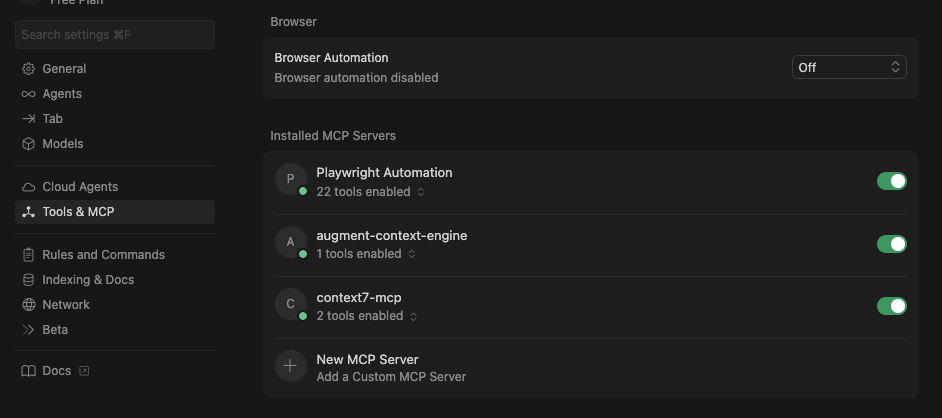 **MacOS or Linux**
On MacOS or Linux, use this config:
```json theme={null}
{
"mcpServers": {
"augment-context-engine": {
"type": "local",
"command": "bash",
"args": [
"-c",
"auggie --mcp -m default -w \"${WORKSPACE_FOLDER_PATHS%%,*}\""
],
"enabled": true
}
}
}
```
**Windows**
On Windows, use this config:
```json theme={null}
{
"mcpServers": {
"augment-context-engine": {
"type": "local",
"command": "powershell",
"args": [
"-Command",
"auggie --mcp -m default -w \"($env:WORKSPACE_FOLDER_PATHS -split ',')[0]\""
],
"enabled": true
}
}
}
```
### 4. Test the integration
```
Prompt : "What is this project ? Please use codebase retrieval tool to get the answer."
```
Cursor should confirm it has access to the `codebase-retrieval` tool.
**MacOS or Linux**
On MacOS or Linux, use this config:
```json theme={null}
{
"mcpServers": {
"augment-context-engine": {
"type": "local",
"command": "bash",
"args": [
"-c",
"auggie --mcp -m default -w \"${WORKSPACE_FOLDER_PATHS%%,*}\""
],
"enabled": true
}
}
}
```
**Windows**
On Windows, use this config:
```json theme={null}
{
"mcpServers": {
"augment-context-engine": {
"type": "local",
"command": "powershell",
"args": [
"-Command",
"auggie --mcp -m default -w \"($env:WORKSPACE_FOLDER_PATHS -split ',')[0]\""
],
"enabled": true
}
}
}
```
### 4. Test the integration
```
Prompt : "What is this project ? Please use codebase retrieval tool to get the answer."
```
Cursor should confirm it has access to the `codebase-retrieval` tool.
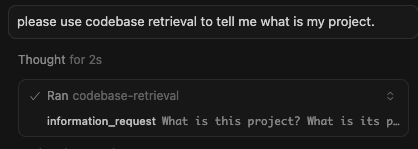 # Quickstart (Droid)
Source: https://docs.augmentcode.com/context-services/mcp/quickstart-droid
Get started with Augment Context Engine MCP in Droid in minutes
## Quick Start with Droid
### 1. Install Auggie CLI (Pre-release version)
```bash theme={null}
npm install -g @augmentcode/auggie@prerelease
```
### 2. Sign in to Augment
```bash theme={null}
auggie login
```
This will open a browser window for authentication.
### 3. Configure the MCP server in Droid
Add the Augment Context Engine MCP server:
```bash theme={null}
droid mcp add augment-code "auggie" --mcp
```
### 4. Test the integration
```
Prompt: "Do you have access to the Augment codebase retrieval tool?"
```
Droid should confirm it has access to the `codebase-retrieval` tool.
## Advanced: Non-Interactive Setup
For non-interactive environments like CI/CD pipelines, GitHub Actions, or automated scripts where you cannot run `auggie login` interactively, you can configure authentication using environment variables.
### 1. Get your authentication token
```bash theme={null}
auggie token print
```
This will output something like:
```
TOKEN={"accessToken":"your-access-token","tenantURL":"your-tenant-url","scopes":["read","write"]}
```
Copy the `accessToken` value (the long string after `"accessToken":"`) and the `tenantURL` value.
### 2. Configure with environment variables
```bash theme={null}
droid mcp add augment-code "auggie" --mcp --env AUGMENT_API_TOKEN=your-access-token --env AUGMENT_API_URL=your-tenant-url
```
Replace `your-access-token` and `your-tenant-url` with the values from step 1.
For a specific workspace:
```bash theme={null}
droid mcp add augment-code "auggie" -w /path/to/project --mcp --env AUGMENT_API_TOKEN=your-access-token --env AUGMENT_API_URL=your-tenant-url
```
# Quickstart (Gemini CLI)
Source: https://docs.augmentcode.com/context-services/mcp/quickstart-gemini-cli
Get started with Augment Context Engine MCP in Gemini CLI in minutes
## Quick Start with Gemini CLI
### 1. Install Auggie CLI (Pre-release version)
```bash theme={null}
npm install -g @augmentcode/auggie@prerelease
```
### 2. Sign in to Augment
```bash theme={null}
auggie login
```
This will open a browser window for authentication.
### 3. Configure the MCP server in Gemini CLI
Gemini CLI reads the MCP server configuration from a settings file. You can configure MCP servers at either the user level (applies to all projects) or project level (applies only to that specific project):
**Configuration file locations:**
* **User settings** (global):
* macOS/Linux: `~/.gemini/settings.json`
* Windows: `%USERPROFILE%\.gemini\settings.json`
* **Project settings** (optional): `.gemini/settings.json` in your project's root directory
Add the following configuration to your Gemini CLI settings file:
```json theme={null}
{
"mcpServers": {
"augment-context-engine": {
"command": "auggie",
"args": [
"--mcp"
]
}
}
}
```
### 4. Test the integration
Prompt the Gemini CLI with:
```
"What is this project? Please use codebase retrieval tool to get the answer."
```
Gemini CLI should confirm it has access to the `codebase-retrieval` tool.
## Configuration
### Workspace Root
Specify the workspace to index by adding the `-w` argument. Update the **/path/to/project**.
```json theme={null}
{
"mcpServers": {
"augment-context-engine": {
"command": "auggie",
"args": ["-w", "/path/to/project", "--mcp"]
}
}
}
```
## Advanced: Non-Interactive Setup
For non-interactive environments like CI/CD pipelines, GitHub Actions, or automated scripts where you cannot run `auggie login` interactively, you can configure authentication using environment variables.
### 1. Get your authentication token
```bash theme={null}
auggie token print
```
This will output something like:
```
TOKEN={"accessToken":"your-access-token","tenantURL":"your-tenant-url","scopes":["read","write"]}
```
Copy the `accessToken` value (the long string after `"accessToken":"`) and the `tenantURL` value.
### 2. Configure with environment variables
Add the `env` section to your configuration:
```json theme={null}
{
"mcpServers": {
"augment-context-engine": {
"command": "auggie",
"args": ["--mcp"],
"env": {
"AUGMENT_API_TOKEN": "your-access-token",
"AUGMENT_API_URL": "your-tenant-url"
}
}
}
}
```
Replace `your-access-token` and `your-tenant-url` with the values from step 1.
For a specific workspace:
```json theme={null}
{
"mcpServers": {
"augment-context-engine": {
"command": "auggie",
"args": ["-w", "/path/to/project", "--mcp"],
"env": {
"AUGMENT_API_TOKEN": "your-access-token",
"AUGMENT_API_URL": "your-tenant-url"
}
}
}
}
```
# Quickstart (GitHub Copilot)
Source: https://docs.augmentcode.com/context-services/mcp/quickstart-github-copilot
Get started with Augment Context Engine MCP in GitHub Copilot in minutes
## Quick Start with GitHub Copilot
### 1. Install Auggie CLI (Pre-release version)
```bash theme={null}
npm install -g @augmentcode/auggie@prerelease
```
### 2. Sign in to Augment
```bash theme={null}
auggie login
```
This will open a browser window for authentication.
### 3. Configure the MCP server in GitHub Copilot
* Please create the following file **at the root** of your project: **.vscode/mcp.json**
* Paste this content inside and **Save**
```json theme={null}
{
"servers": {
"augmentcode": {
"type": "stdio",
"command": "auggie",
"args": ["--mcp", "-m", "default"]
}
},
"inputs": []
}
```
### 4. Test the integration
Prompt this in **AGENT MODE**: "What is this project? Please use codebase retrieval tool to get the answer."
Copilot should confirm it has access to the `codebase-retrieval` tool.
# Quickstart (Droid)
Source: https://docs.augmentcode.com/context-services/mcp/quickstart-droid
Get started with Augment Context Engine MCP in Droid in minutes
## Quick Start with Droid
### 1. Install Auggie CLI (Pre-release version)
```bash theme={null}
npm install -g @augmentcode/auggie@prerelease
```
### 2. Sign in to Augment
```bash theme={null}
auggie login
```
This will open a browser window for authentication.
### 3. Configure the MCP server in Droid
Add the Augment Context Engine MCP server:
```bash theme={null}
droid mcp add augment-code "auggie" --mcp
```
### 4. Test the integration
```
Prompt: "Do you have access to the Augment codebase retrieval tool?"
```
Droid should confirm it has access to the `codebase-retrieval` tool.
## Advanced: Non-Interactive Setup
For non-interactive environments like CI/CD pipelines, GitHub Actions, or automated scripts where you cannot run `auggie login` interactively, you can configure authentication using environment variables.
### 1. Get your authentication token
```bash theme={null}
auggie token print
```
This will output something like:
```
TOKEN={"accessToken":"your-access-token","tenantURL":"your-tenant-url","scopes":["read","write"]}
```
Copy the `accessToken` value (the long string after `"accessToken":"`) and the `tenantURL` value.
### 2. Configure with environment variables
```bash theme={null}
droid mcp add augment-code "auggie" --mcp --env AUGMENT_API_TOKEN=your-access-token --env AUGMENT_API_URL=your-tenant-url
```
Replace `your-access-token` and `your-tenant-url` with the values from step 1.
For a specific workspace:
```bash theme={null}
droid mcp add augment-code "auggie" -w /path/to/project --mcp --env AUGMENT_API_TOKEN=your-access-token --env AUGMENT_API_URL=your-tenant-url
```
# Quickstart (Gemini CLI)
Source: https://docs.augmentcode.com/context-services/mcp/quickstart-gemini-cli
Get started with Augment Context Engine MCP in Gemini CLI in minutes
## Quick Start with Gemini CLI
### 1. Install Auggie CLI (Pre-release version)
```bash theme={null}
npm install -g @augmentcode/auggie@prerelease
```
### 2. Sign in to Augment
```bash theme={null}
auggie login
```
This will open a browser window for authentication.
### 3. Configure the MCP server in Gemini CLI
Gemini CLI reads the MCP server configuration from a settings file. You can configure MCP servers at either the user level (applies to all projects) or project level (applies only to that specific project):
**Configuration file locations:**
* **User settings** (global):
* macOS/Linux: `~/.gemini/settings.json`
* Windows: `%USERPROFILE%\.gemini\settings.json`
* **Project settings** (optional): `.gemini/settings.json` in your project's root directory
Add the following configuration to your Gemini CLI settings file:
```json theme={null}
{
"mcpServers": {
"augment-context-engine": {
"command": "auggie",
"args": [
"--mcp"
]
}
}
}
```
### 4. Test the integration
Prompt the Gemini CLI with:
```
"What is this project? Please use codebase retrieval tool to get the answer."
```
Gemini CLI should confirm it has access to the `codebase-retrieval` tool.
## Configuration
### Workspace Root
Specify the workspace to index by adding the `-w` argument. Update the **/path/to/project**.
```json theme={null}
{
"mcpServers": {
"augment-context-engine": {
"command": "auggie",
"args": ["-w", "/path/to/project", "--mcp"]
}
}
}
```
## Advanced: Non-Interactive Setup
For non-interactive environments like CI/CD pipelines, GitHub Actions, or automated scripts where you cannot run `auggie login` interactively, you can configure authentication using environment variables.
### 1. Get your authentication token
```bash theme={null}
auggie token print
```
This will output something like:
```
TOKEN={"accessToken":"your-access-token","tenantURL":"your-tenant-url","scopes":["read","write"]}
```
Copy the `accessToken` value (the long string after `"accessToken":"`) and the `tenantURL` value.
### 2. Configure with environment variables
Add the `env` section to your configuration:
```json theme={null}
{
"mcpServers": {
"augment-context-engine": {
"command": "auggie",
"args": ["--mcp"],
"env": {
"AUGMENT_API_TOKEN": "your-access-token",
"AUGMENT_API_URL": "your-tenant-url"
}
}
}
}
```
Replace `your-access-token` and `your-tenant-url` with the values from step 1.
For a specific workspace:
```json theme={null}
{
"mcpServers": {
"augment-context-engine": {
"command": "auggie",
"args": ["-w", "/path/to/project", "--mcp"],
"env": {
"AUGMENT_API_TOKEN": "your-access-token",
"AUGMENT_API_URL": "your-tenant-url"
}
}
}
}
```
# Quickstart (GitHub Copilot)
Source: https://docs.augmentcode.com/context-services/mcp/quickstart-github-copilot
Get started with Augment Context Engine MCP in GitHub Copilot in minutes
## Quick Start with GitHub Copilot
### 1. Install Auggie CLI (Pre-release version)
```bash theme={null}
npm install -g @augmentcode/auggie@prerelease
```
### 2. Sign in to Augment
```bash theme={null}
auggie login
```
This will open a browser window for authentication.
### 3. Configure the MCP server in GitHub Copilot
* Please create the following file **at the root** of your project: **.vscode/mcp.json**
* Paste this content inside and **Save**
```json theme={null}
{
"servers": {
"augmentcode": {
"type": "stdio",
"command": "auggie",
"args": ["--mcp", "-m", "default"]
}
},
"inputs": []
}
```
### 4. Test the integration
Prompt this in **AGENT MODE**: "What is this project? Please use codebase retrieval tool to get the answer."
Copilot should confirm it has access to the `codebase-retrieval` tool.
 # Quickstart (Kilo)
Source: https://docs.augmentcode.com/context-services/mcp/quickstart-kilo
Get started with Augment Context Engine MCP in Kilo in minutes
## Quick Start with Kilo
### 1. Install Auggie CLI (Pre-release version)
```bash theme={null}
npm install -g @augmentcode/auggie@prerelease
```
### 2. Sign in to Augment
```bash theme={null}
auggie login
```
This will open a browser window for authentication.
### 3. Configure the MCP server in Kilo
* Click the MCP server icon
# Quickstart (Kilo)
Source: https://docs.augmentcode.com/context-services/mcp/quickstart-kilo
Get started with Augment Context Engine MCP in Kilo in minutes
## Quick Start with Kilo
### 1. Install Auggie CLI (Pre-release version)
```bash theme={null}
npm install -g @augmentcode/auggie@prerelease
```
### 2. Sign in to Augment
```bash theme={null}
auggie login
```
This will open a browser window for authentication.
### 3. Configure the MCP server in Kilo
* Click the MCP server icon
 * Click Edit Global MCP
* Click Edit Global MCP
 Paste this configuration:
```json theme={null}
{
"mcpServers": {
"augment-context-engine": {
"command":"auggie",
"type":"stdio",
"args":["--mcp"],
"disabled":false,
"alwaysAllow":["codebase-retrieval"]
}
}
}
```
### 4. Test the integration
Prompt: "What is this project ? Please use codebase retrieval tool to get the answer."
Kilo should confirm it has access to the `codebase-retrieval` tool.
Paste this configuration:
```json theme={null}
{
"mcpServers": {
"augment-context-engine": {
"command":"auggie",
"type":"stdio",
"args":["--mcp"],
"disabled":false,
"alwaysAllow":["codebase-retrieval"]
}
}
}
```
### 4. Test the integration
Prompt: "What is this project ? Please use codebase retrieval tool to get the answer."
Kilo should confirm it has access to the `codebase-retrieval` tool.
 # Quickstart (Kiro)
Source: https://docs.augmentcode.com/context-services/mcp/quickstart-kiro
Get started with Augment Context Engine MCP in Kiro in minutes
## Quick Start with Kiro
### 1. Install Auggie CLI (Pre-release version)
```bash theme={null}
npm install -g @augmentcode/auggie@prerelease
```
### 2. Sign in to Augment
```bash theme={null}
auggie login
```
This will open a browser window for authentication.
### 3. Configure the MCP server in Kiro
Open the command palette (`Cmd + Shift + P` on Mac, `Ctrl + Shift + P` on Windows/Linux) and select:
* **Kiro: Open workspace MCP config (JSON)** - For workspace-level configuration
* **Kiro: Open user MCP config (JSON)** - For user-level configuration
Paste this configuration:
```json theme={null}
{
"mcpServers": {
"Augment-Context-Engine": {
"command": "auggie",
"args": ["--mcp", "-m", "default", "-w", "./"],
"disabled": false,
"autoApprove": ["codebase-retrieval"]
}
}
}
```
### 4. Test the integration
```
Prompt: "Do you have access to the Augment codebase retrieval tool?"
```
Kiro should confirm it has access to the `codebase-retrieval` tool.
# Quickstart (OpenCode)
Source: https://docs.augmentcode.com/context-services/mcp/quickstart-open-code
Get started with Augment Context Engine MCP in OpenCode in minutes
## Quick Start with OpenCode
### 1. Install Auggie CLI (Pre-release version)
```bash theme={null}
npm install -g @augmentcode/auggie@prerelease
```
### 2. Sign in to Augment
```bash theme={null}
auggie login
```
This will open a browser window for authentication.
### 3. Configure the MCP server in OpenCode
* Go to Folder: \~/.config/opencode/
* Create a file named: opencode.json
Paste this configuration:
```json theme={null}
{
"$schema": "https://opencode.ai/config.json",
"mcp": {
"augment-context-engine": {
"type": "local",
"command": ["auggie", "--mcp"],
"enabled": true
}
}
}
```
### 4. Test the integration
```
Prompt : "What is this project ? Please use codebase retrieval tool to get the answer."
```
OpenCode should confirm it has access to the `codebase-retrieval` tool.
# Quickstart (Kiro)
Source: https://docs.augmentcode.com/context-services/mcp/quickstart-kiro
Get started with Augment Context Engine MCP in Kiro in minutes
## Quick Start with Kiro
### 1. Install Auggie CLI (Pre-release version)
```bash theme={null}
npm install -g @augmentcode/auggie@prerelease
```
### 2. Sign in to Augment
```bash theme={null}
auggie login
```
This will open a browser window for authentication.
### 3. Configure the MCP server in Kiro
Open the command palette (`Cmd + Shift + P` on Mac, `Ctrl + Shift + P` on Windows/Linux) and select:
* **Kiro: Open workspace MCP config (JSON)** - For workspace-level configuration
* **Kiro: Open user MCP config (JSON)** - For user-level configuration
Paste this configuration:
```json theme={null}
{
"mcpServers": {
"Augment-Context-Engine": {
"command": "auggie",
"args": ["--mcp", "-m", "default", "-w", "./"],
"disabled": false,
"autoApprove": ["codebase-retrieval"]
}
}
}
```
### 4. Test the integration
```
Prompt: "Do you have access to the Augment codebase retrieval tool?"
```
Kiro should confirm it has access to the `codebase-retrieval` tool.
# Quickstart (OpenCode)
Source: https://docs.augmentcode.com/context-services/mcp/quickstart-open-code
Get started with Augment Context Engine MCP in OpenCode in minutes
## Quick Start with OpenCode
### 1. Install Auggie CLI (Pre-release version)
```bash theme={null}
npm install -g @augmentcode/auggie@prerelease
```
### 2. Sign in to Augment
```bash theme={null}
auggie login
```
This will open a browser window for authentication.
### 3. Configure the MCP server in OpenCode
* Go to Folder: \~/.config/opencode/
* Create a file named: opencode.json
Paste this configuration:
```json theme={null}
{
"$schema": "https://opencode.ai/config.json",
"mcp": {
"augment-context-engine": {
"type": "local",
"command": ["auggie", "--mcp"],
"enabled": true
}
}
}
```
### 4. Test the integration
```
Prompt : "What is this project ? Please use codebase retrieval tool to get the answer."
```
OpenCode should confirm it has access to the `codebase-retrieval` tool.
 ## Advanced: Non-Interactive Setup
For non-interactive environments like CI/CD pipelines, GitHub Actions, or automated scripts where you cannot run `auggie login` interactively, you can configure authentication using environment variables.
### 1. Get your authentication token
```bash theme={null}
auggie token print
```
This will output something like:
```
TOKEN={"accessToken":"your-access-token","tenantURL":"your-tenant-url","scopes":["read","write"]}
```
Copy the `accessToken` value (the long string after `"accessToken":"`) and the `tenantURL` value.
### 2. Configure with environment variables
Add the `env` section to your configuration:
```json theme={null}
{
"$schema": "https://opencode.ai/config.json",
"mcp": {
"augment-context-engine": {
"type": "local",
"command": ["auggie", "--mcp"],
"enabled": true,
"env": {
"AUGMENT_API_TOKEN": "your-access-token",
"AUGMENT_API_URL": "your-tenant-url"
}
}
}
}
```
Replace `your-access-token` and `your-tenant-url` with the values from step 1.
# Quickstart (Zed)
Source: https://docs.augmentcode.com/context-services/mcp/quickstart-zed
Get started with Augment Context Engine MCP in Zed in minutes
## Quick Start with Zed
### 1. Install Auggie CLI (Pre-release version)
```bash theme={null}
npm install -g @augmentcode/auggie@prerelease
```
### 2. Sign in to Augment
```bash theme={null}
auggie login
```
This will open a browser window for authentication.
### 3. Get your authentication token (Only if you set it up remotely, this is not mandatory locally.)
```bash theme={null}
auggie token print
```
This will output something like:
```
TOKEN={"accessToken":"your-access-token","tenantURL":"your-tenant-url","scopes":["read","write"]}
```
Copy the `accessToken` value (the long string after `"accessToken":"`) and the `tenantURL` value for the next step.
### 4. Configure the MCP server in Zed
* Click the ... then **Add Custom Server**
## Advanced: Non-Interactive Setup
For non-interactive environments like CI/CD pipelines, GitHub Actions, or automated scripts where you cannot run `auggie login` interactively, you can configure authentication using environment variables.
### 1. Get your authentication token
```bash theme={null}
auggie token print
```
This will output something like:
```
TOKEN={"accessToken":"your-access-token","tenantURL":"your-tenant-url","scopes":["read","write"]}
```
Copy the `accessToken` value (the long string after `"accessToken":"`) and the `tenantURL` value.
### 2. Configure with environment variables
Add the `env` section to your configuration:
```json theme={null}
{
"$schema": "https://opencode.ai/config.json",
"mcp": {
"augment-context-engine": {
"type": "local",
"command": ["auggie", "--mcp"],
"enabled": true,
"env": {
"AUGMENT_API_TOKEN": "your-access-token",
"AUGMENT_API_URL": "your-tenant-url"
}
}
}
}
```
Replace `your-access-token` and `your-tenant-url` with the values from step 1.
# Quickstart (Zed)
Source: https://docs.augmentcode.com/context-services/mcp/quickstart-zed
Get started with Augment Context Engine MCP in Zed in minutes
## Quick Start with Zed
### 1. Install Auggie CLI (Pre-release version)
```bash theme={null}
npm install -g @augmentcode/auggie@prerelease
```
### 2. Sign in to Augment
```bash theme={null}
auggie login
```
This will open a browser window for authentication.
### 3. Get your authentication token (Only if you set it up remotely, this is not mandatory locally.)
```bash theme={null}
auggie token print
```
This will output something like:
```
TOKEN={"accessToken":"your-access-token","tenantURL":"your-tenant-url","scopes":["read","write"]}
```
Copy the `accessToken` value (the long string after `"accessToken":"`) and the `tenantURL` value for the next step.
### 4. Configure the MCP server in Zed
* Click the ... then **Add Custom Server**
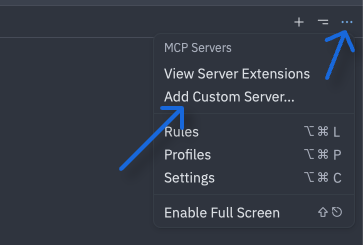 * Paste the config and **Update the /path/to/your/project** this is mandatory in Zed for such MCP (easy copy paste is below the screenshot)
* Paste the config and **Update the /path/to/your/project** this is mandatory in Zed for such MCP (easy copy paste is below the screenshot)
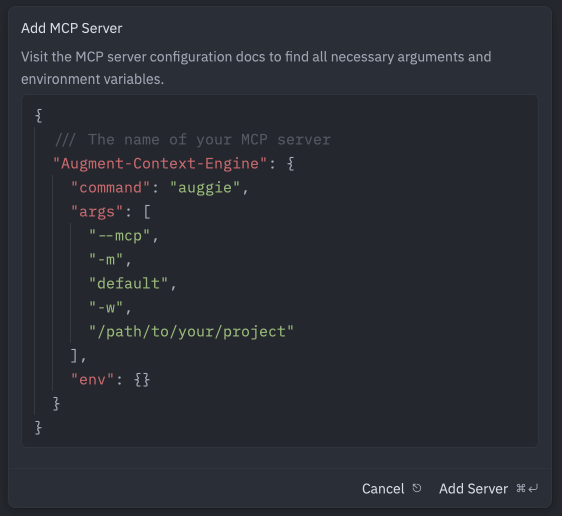 **Local Setup (MacOS or Linux)**\
On MacOS or Linux, use this config:
```
{
"Augment-Context-Engine": {
"enabled": true,
"command": "bash",
"args": [
"-c",
"auggie -m default --mcp -w $(pwd)"
],
"env": {}
}
}
```
On Windows, use the config below. Update the **/path/to/your/project**.
**Local Setup (Windows)**
```
{
"Augment-Context-Engine": {
"command": "auggie",
"args": [
"--mcp",
"-m",
"default",
"-w",
"/path/to/your/project"
],
"env": {}
}
}
```
### 5. Test the integration
Prompt : "What is this project ? Please use codebase retrieval tool to get the answer."\
Zed should confirm it has access to the `codebase-retrieval` tool.
**Local Setup (MacOS or Linux)**\
On MacOS or Linux, use this config:
```
{
"Augment-Context-Engine": {
"enabled": true,
"command": "bash",
"args": [
"-c",
"auggie -m default --mcp -w $(pwd)"
],
"env": {}
}
}
```
On Windows, use the config below. Update the **/path/to/your/project**.
**Local Setup (Windows)**
```
{
"Augment-Context-Engine": {
"command": "auggie",
"args": [
"--mcp",
"-m",
"default",
"-w",
"/path/to/your/project"
],
"env": {}
}
}
```
### 5. Test the integration
Prompt : "What is this project ? Please use codebase retrieval tool to get the answer."\
Zed should confirm it has access to the `codebase-retrieval` tool.
 # Overview
Source: https://docs.augmentcode.com/context-services/overview
Context Services provide context for agents and apps
## What Are Context Services?
Context Services provide high-quality semantic search to AI agents and applications. Whether you're building custom agents or integrating with existing AI tools, Context Services give you access to Augment's world-class context engine.
# Overview
Source: https://docs.augmentcode.com/context-services/overview
Context Services provide context for agents and apps
## What Are Context Services?
Context Services provide high-quality semantic search to AI agents and applications. Whether you're building custom agents or integrating with existing AI tools, Context Services give you access to Augment's world-class context engine.
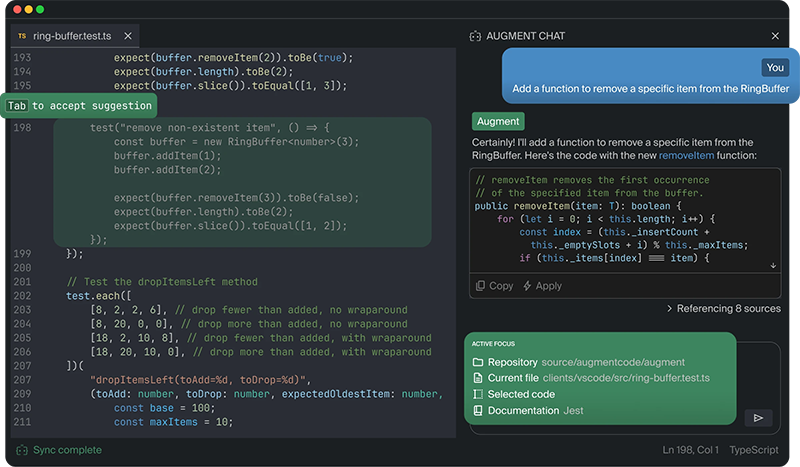 ## Get started in minutes
Augment works with your favorite IDE and your favorite programming language. Download the extension, sign in, and get coding.
## Get started in minutes
Augment works with your favorite IDE and your favorite programming language. Download the extension, sign in, and get coding.
Visual Studio Code
Get completions, chat, and instructions in your favorite open source editor.
JetBrains IDEs
Completions are available for all JetBrains IDEs, like WebStorm, PyCharm, and IntelliJ.

Auggie CLI
All the power of Augment's agent, context engine, and tools in your terminal.
 You'll be redirected to authorize the integration with the appropriate service. After authorization, the integration will be available for use with Augment Agent.
## Easy MCP Integrations
> **New:** Easy MCP launched ONLY July 30, 2025, providing one-click access to popular developer tools.
Easy MCP transforms complex MCP server setup into a single click. Available integrations include:
* **CircleCI** - Build logs, test insights, and flaky-test detection
* **MongoDB** - Data exploration, database management, and context-aware code generation
* **Redis** - Keyspace introspection, TTL audits, and migration helpers
For detailed setup instructions and examples, see [Configure MCP servers](/jetbrains/setup-augment/mcp).
## Native Integrations
##
You'll be redirected to authorize the integration with the appropriate service. After authorization, the integration will be available for use with Augment Agent.
## Easy MCP Integrations
> **New:** Easy MCP launched ONLY July 30, 2025, providing one-click access to popular developer tools.
Easy MCP transforms complex MCP server setup into a single click. Available integrations include:
* **CircleCI** - Build logs, test insights, and flaky-test detection
* **MongoDB** - Data exploration, database management, and context-aware code generation
* **Redis** - Keyspace introspection, TTL audits, and migration helpers
For detailed setup instructions and examples, see [Configure MCP servers](/jetbrains/setup-augment/mcp).
## Native Integrations
##  ## Installing Augment for JetBrains IDEs
## Installing Augment for JetBrains IDEs
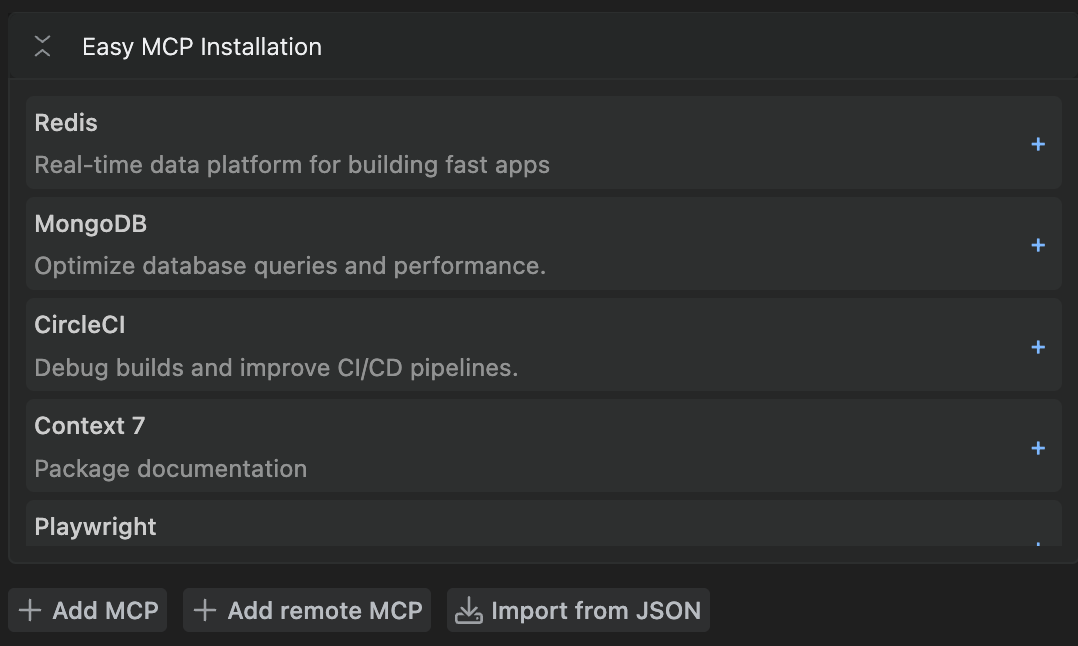 From that moment on, Augment Code streams your tool's live context into every suggestion and autonomous Agent run.
## Advanced Configuration: Settings Panel
For developers who need custom MCP server configurations or want to use servers not available through Easy MCP, you can configure MCP servers manually using the Augment Settings Panel.
To access the settings panel, select the gear icon in the upper right of the Augment panel. Once the settings panel is open, you will see a section for MCP servers.
From that moment on, Augment Code streams your tool's live context into every suggestion and autonomous Agent run.
## Advanced Configuration: Settings Panel
For developers who need custom MCP server configurations or want to use servers not available through Easy MCP, you can configure MCP servers manually using the Augment Settings Panel.
To access the settings panel, select the gear icon in the upper right of the Augment panel. Once the settings panel is open, you will see a section for MCP servers.
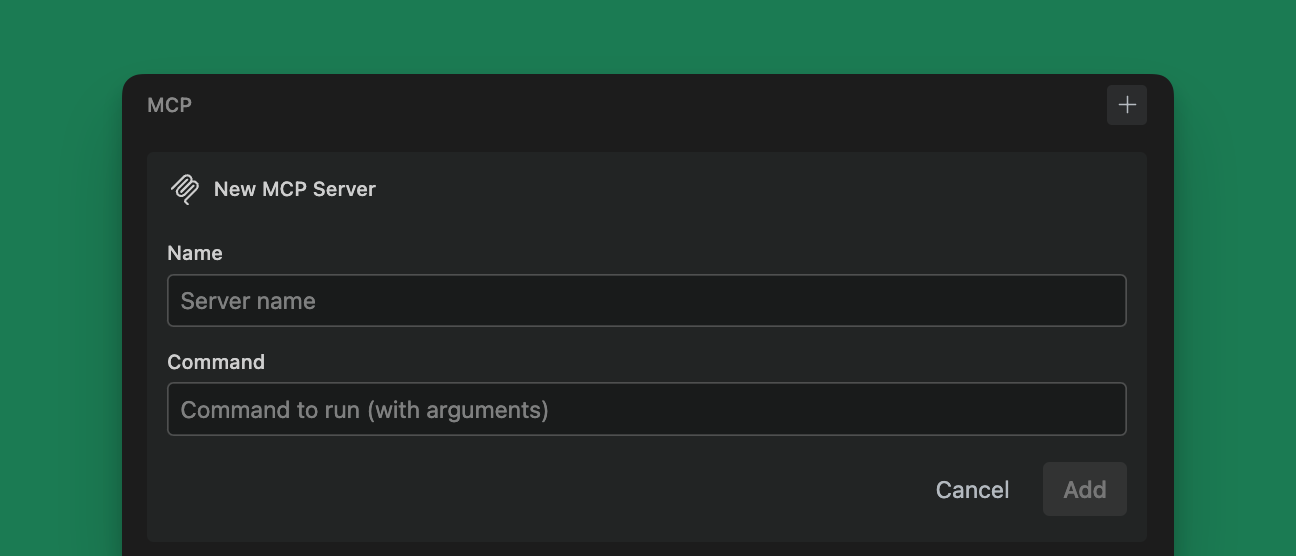 Fill in the `name` and `command` fields. The `name` field must be a unique name for the server. The `command` field is the command to run the server. Environment variables have their own section and no longer need to be specified in the command.
Fill in the `name` and `command` fields. The `name` field must be a unique name for the server. The `command` field is the command to run the server. Environment variables have their own section and no longer need to be specified in the command.
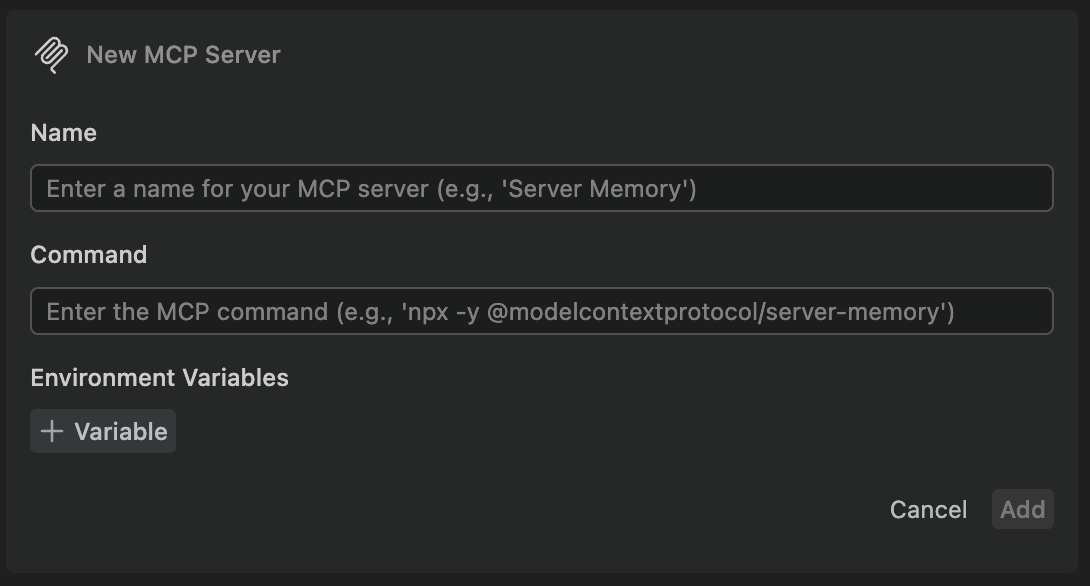 To add additional servers, click the `+` button next to the `MCP` header.
To edit a configuration or to delete a server, click the `...` button next to the server name.
### Add a Remote MCP server
If your MCP server runs remotely (for example, a hosted service), click the "+ Add remote MCP" button in the MCP section. Remote MCP connections support both HTTP and SSE (Server‑Sent Events).
To add additional servers, click the `+` button next to the `MCP` header.
To edit a configuration or to delete a server, click the `...` button next to the server name.
### Add a Remote MCP server
If your MCP server runs remotely (for example, a hosted service), click the "+ Add remote MCP" button in the MCP section. Remote MCP connections support both HTTP and SSE (Server‑Sent Events).
 * Connection Type: choose HTTP or SSE
* Name: a unique display name for the server
* URL: the base URL to your MCP server (e.g., [https://api.example.com](https://api.example.com))
Remote MCP servers appear alongside your local MCP servers in the list. You can edit or remove them using the "..." menu next to the server name.
## Server compatibility
Not all MCP servers are compatible with Augment's models. The MCP standard, implementation of specific servers, and Augment's MCP support are frequently being updated, so check compatibility frequently.
# Index your workspace
Source: https://docs.augmentcode.com/jetbrains/setup-augment/workspace-indexing
When your workspace is indexed, Augment can provide tailored code suggestions and answers based on your unique codebase, best practices, coding patterns, and preferences. You can always control what files are indexed.
## About indexing your workspace
When you open a workspace with Augment enabled, your codebase will be automatically uploaded to Augment's secure cloud. You can control what files get indexed using `.gitignore` and `.augmentignore` files. Indexing usually takes less than a minute but can take longer depending on the size of your codebase.
## Security and privacy
Augment stores your code securely and privately to enable our powerful context engine. We ensure code privacy through a proof-of-possession API and maintain strict internal data minimization principles. [Read more about our security](https://www.augmentcode.com/security).
## What gets indexed
Augment will index all the files in your workspace, except for the files that match patterns in your `.gitignore` file and the `.augmentignore` file.
## Ignoring files with .augmentignore
The `.augmentignore` file is a list of file patterns that Augment will ignore when indexing your workspace. Create an `.augmentignore` file in the root of your workspace. You can use any glob pattern that is supported by the [gitignore](https://git-scm.com/docs/gitignore) file.
## Including files that are .gitignored
If you have a file or directory in your `.gitignore` that you want to indexed, you can add it to your `.augmentignore` file using the `!` prefix.
For example, you may want your `node_modules` indexed to provide Augment with context about the dependencies in their project, but it is typically included in their `.gitignore`. Add `!node_modules` to your `.augmentignore` file.
* Connection Type: choose HTTP or SSE
* Name: a unique display name for the server
* URL: the base URL to your MCP server (e.g., [https://api.example.com](https://api.example.com))
Remote MCP servers appear alongside your local MCP servers in the list. You can edit or remove them using the "..." menu next to the server name.
## Server compatibility
Not all MCP servers are compatible with Augment's models. The MCP standard, implementation of specific servers, and Augment's MCP support are frequently being updated, so check compatibility frequently.
# Index your workspace
Source: https://docs.augmentcode.com/jetbrains/setup-augment/workspace-indexing
When your workspace is indexed, Augment can provide tailored code suggestions and answers based on your unique codebase, best practices, coding patterns, and preferences. You can always control what files are indexed.
## About indexing your workspace
When you open a workspace with Augment enabled, your codebase will be automatically uploaded to Augment's secure cloud. You can control what files get indexed using `.gitignore` and `.augmentignore` files. Indexing usually takes less than a minute but can take longer depending on the size of your codebase.
## Security and privacy
Augment stores your code securely and privately to enable our powerful context engine. We ensure code privacy through a proof-of-possession API and maintain strict internal data minimization principles. [Read more about our security](https://www.augmentcode.com/security).
## What gets indexed
Augment will index all the files in your workspace, except for the files that match patterns in your `.gitignore` file and the `.augmentignore` file.
## Ignoring files with .augmentignore
The `.augmentignore` file is a list of file patterns that Augment will ignore when indexing your workspace. Create an `.augmentignore` file in the root of your workspace. You can use any glob pattern that is supported by the [gitignore](https://git-scm.com/docs/gitignore) file.
## Including files that are .gitignored
If you have a file or directory in your `.gitignore` that you want to indexed, you can add it to your `.augmentignore` file using the `!` prefix.
For example, you may want your `node_modules` indexed to provide Augment with context about the dependencies in their project, but it is typically included in their `.gitignore`. Add `!node_modules` to your `.augmentignore` file.
 ### Choosing a model
Use the model dropdown in the Augment panel to switch between Claude Sonnet 4 and GPT-5. Your selection applies only to Agent for the current workspace and can be changed at any time. See [Available Models](/models/available-models) for details.
## Using Agent
To use Agent, simply type your request into the input box using natural language and click the submit button. You will see the default context including current workspace, current file, and Agent memories. You can add additional context by clicking
### Choosing a model
Use the model dropdown in the Augment panel to switch between Claude Sonnet 4 and GPT-5. Your selection applies only to Agent for the current workspace and can be changed at any time. See [Available Models](/models/available-models) for details.
## Using Agent
To use Agent, simply type your request into the input box using natural language and click the submit button. You will see the default context including current workspace, current file, and Agent memories. You can add additional context by clicking 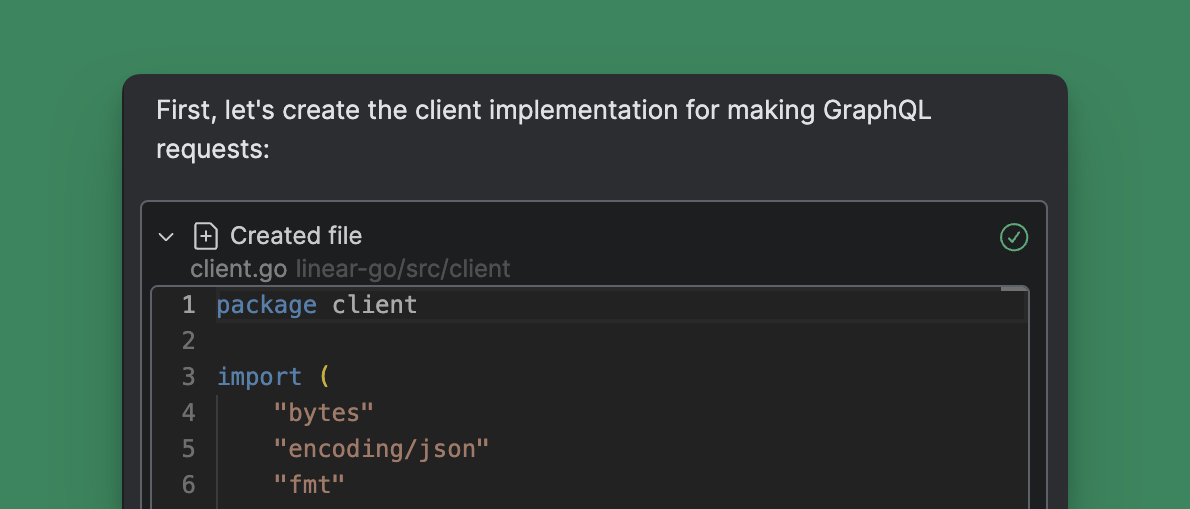 ### Checkpoints
Checkpoints are automatically saved snapshots of your workspace as Agent implements the plan allowing you to easily revert back to a previous step. This enables Agent to continue working while you review code changes and commands results. To revert to a previous checkpoint, click the reverse arrow to restore your code.
### Checkpoints
Checkpoints are automatically saved snapshots of your workspace as Agent implements the plan allowing you to easily revert back to a previous step. This enables Agent to continue working while you review code changes and commands results. To revert to a previous checkpoint, click the reverse arrow to restore your code.
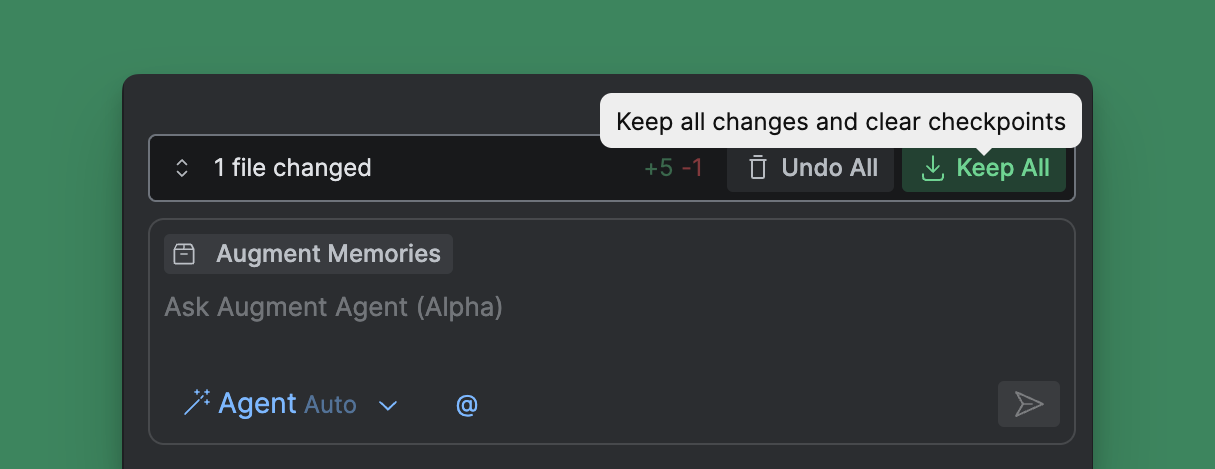 ### Agent vs Agent Auto
By default, Agent will pause work when it needs to execute a terminal command or access external integrations. After reviewing the suggested action, click the blue play button to have Agent execute the command and continue working. You tell Agent to skip a specific action by clicking on the three dots and then Skip.
### Agent vs Agent Auto
By default, Agent will pause work when it needs to execute a terminal command or access external integrations. After reviewing the suggested action, click the blue play button to have Agent execute the command and continue working. You tell Agent to skip a specific action by clicking on the three dots and then Skip.
 In Agent Auto, Agent will act more independently. It will edit files, execute terminal commands, and access tools like MCP servers automatically.
### Stop or guide the Agent
You can interrupt the Agent at any time by clicking Stop. This will pause the action to allow you to correct something you see the agent doing incorrectly. While Agent is working, you can also prompt the Agent to try a different approach which will automatically stop the agent and prompt it to correct its course.
In Agent Auto, Agent will act more independently. It will edit files, execute terminal commands, and access tools like MCP servers automatically.
### Stop or guide the Agent
You can interrupt the Agent at any time by clicking Stop. This will pause the action to allow you to correct something you see the agent doing incorrectly. While Agent is working, you can also prompt the Agent to try a different approach which will automatically stop the agent and prompt it to correct its course.
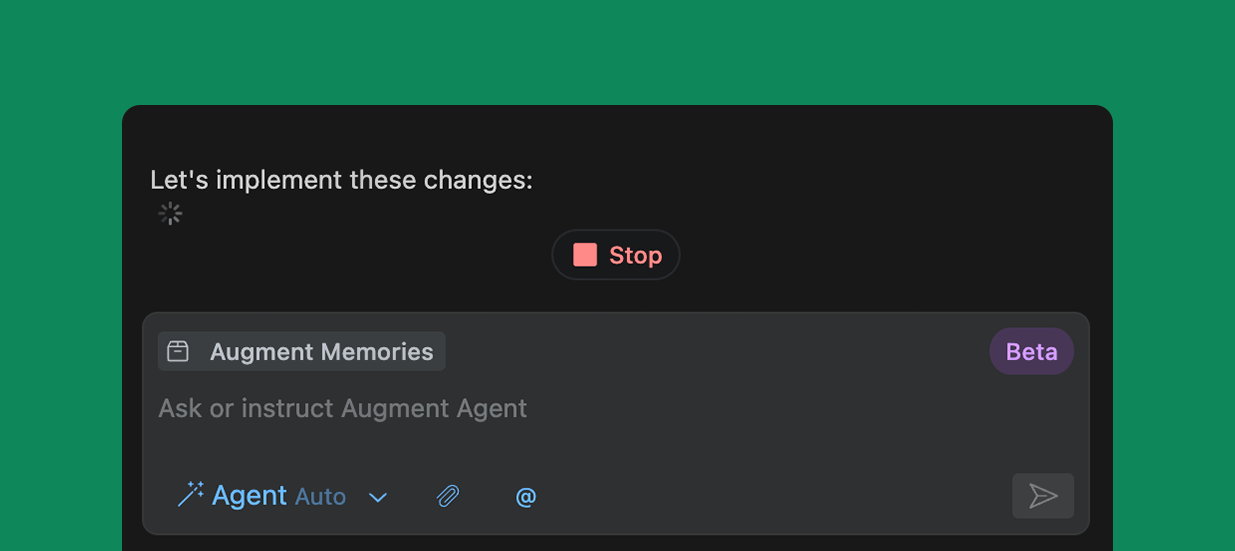 ### Quick Ask Mode
Quick Ask Mode is a toggle button in the agent chat interface that restricts the AI to read-only tools only. When activated, it adds a visual badge to the message and focuses the AI on information gathering without making any changes to your codebase.
### Quick Ask Mode
Quick Ask Mode is a toggle button in the agent chat interface that restricts the AI to read-only tools only. When activated, it adds a visual badge to the message and focuses the AI on information gathering without making any changes to your codebase.
 ### Comparison to Chat
Agent takes Chat to the next level by allowing Augment to do things for you-that is create and make modifications directly to your codebase. Chat can explain code, create plans, and suggest changes which you can smartly apply one-by-one, but Agent takes it a step further by automatically implementing the entire plan and all code changes for you.
| What are you trying to do? | Chat | Agent |
| :----------------------------------------------- | :--: | :---: |
| Ask questions about your code | ☑️ | ✅ |
| Get advice on how to refactor code | ☑️ | ✅ |
| Add new features to selected lines of code | ☑️ | ✅ |
| Add new feature spanning multiple files | | ✅ |
| Document new features | | ✅ |
| Queue up tests for you in the terminal | | ✅ |
| Open Linear tickets or start a pull request | | ✅ |
| Start a new branch in GitHub from recent commits | | ✅ |
| Automatically perform tasks on your behalf | | ✅ |
### Use cases
Use Agent to handle various aspects of your software development workflow, from simple configuration changes to complex feature implementations. Agent supports your daily engineering tasks like:
* **Make quick edits** - Create a pull request to adjust configuration values like feature flags from FALSE to TRUE
* **Perform refactoring** - Move functions between files while maintaining coding conventions and ensuring bug-free operation
* **Start a first draft for new features** - Start a pull request (PR) with implementing entirely new functionality straight from a GitHub Issue or Linear Ticket
* **Branch from GitHub** - Open a PR from GitHub based on recent commits that creates a new branch
* **Query Supabase tables directly** - Ask Agent to view the contents of a table
* **Start tickets in Linear or Jira** - Open tickets and ask Agent to suggest a plan to address the ticket
* **Add Pull Request descriptions** - Merge your PR into a branch then tell the agent to explain what the changes are and why they were made
* **Create test coverage** - Generate unit tests for your newly developed features
* **Generate documentation** - Produce comprehensive documentation for your libraries and features
* **Start a README** - Write a README for a new feature or updated function that you just wrote
* **Track development progress** - Review and summarize your recent Git commits for better visibility with the GitHub integration
## Next steps
* [Configure Agent Integrations](/jetbrains/setup-augment/agent-integrations)
# Using Chat
Source: https://docs.augmentcode.com/jetbrains/using-augment/chat
Use Chat to explore your codebase, quickly get up to speed on unfamiliar code, and get help working through a technical problem.
export const type_0 = "chats"
export const DeleteIcon = () =>
### Comparison to Chat
Agent takes Chat to the next level by allowing Augment to do things for you-that is create and make modifications directly to your codebase. Chat can explain code, create plans, and suggest changes which you can smartly apply one-by-one, but Agent takes it a step further by automatically implementing the entire plan and all code changes for you.
| What are you trying to do? | Chat | Agent |
| :----------------------------------------------- | :--: | :---: |
| Ask questions about your code | ☑️ | ✅ |
| Get advice on how to refactor code | ☑️ | ✅ |
| Add new features to selected lines of code | ☑️ | ✅ |
| Add new feature spanning multiple files | | ✅ |
| Document new features | | ✅ |
| Queue up tests for you in the terminal | | ✅ |
| Open Linear tickets or start a pull request | | ✅ |
| Start a new branch in GitHub from recent commits | | ✅ |
| Automatically perform tasks on your behalf | | ✅ |
### Use cases
Use Agent to handle various aspects of your software development workflow, from simple configuration changes to complex feature implementations. Agent supports your daily engineering tasks like:
* **Make quick edits** - Create a pull request to adjust configuration values like feature flags from FALSE to TRUE
* **Perform refactoring** - Move functions between files while maintaining coding conventions and ensuring bug-free operation
* **Start a first draft for new features** - Start a pull request (PR) with implementing entirely new functionality straight from a GitHub Issue or Linear Ticket
* **Branch from GitHub** - Open a PR from GitHub based on recent commits that creates a new branch
* **Query Supabase tables directly** - Ask Agent to view the contents of a table
* **Start tickets in Linear or Jira** - Open tickets and ask Agent to suggest a plan to address the ticket
* **Add Pull Request descriptions** - Merge your PR into a branch then tell the agent to explain what the changes are and why they were made
* **Create test coverage** - Generate unit tests for your newly developed features
* **Generate documentation** - Produce comprehensive documentation for your libraries and features
* **Start a README** - Write a README for a new feature or updated function that you just wrote
* **Track development progress** - Review and summarize your recent Git commits for better visibility with the GitHub integration
## Next steps
* [Configure Agent Integrations](/jetbrains/setup-augment/agent-integrations)
# Using Chat
Source: https://docs.augmentcode.com/jetbrains/using-augment/chat
Use Chat to explore your codebase, quickly get up to speed on unfamiliar code, and get help working through a technical problem.
export const type_0 = "chats"
export const DeleteIcon = () =>  ## Accessing Chat
Access the Chat sidebar by clicking the Augment icon
## Accessing Chat
Access the Chat sidebar by clicking the Augment icon 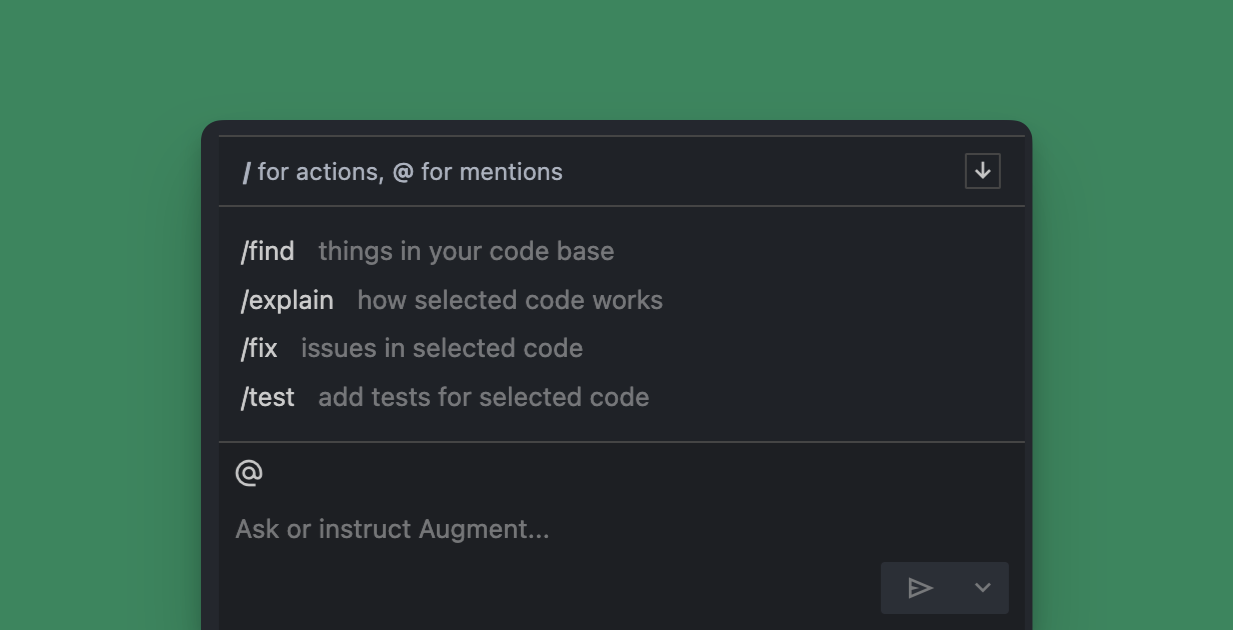 ## Using actions in Chat
To use a quick action, you an use a
## Using actions in Chat
To use a quick action, you an use a  ## Using code blocks from within Chat
Whenever Chat responds with code, you will have the option to add the code to your codebase. The most common option will be shown as a button and you can access the other options by clicking the overflow menu icon
## Using code blocks from within Chat
Whenever Chat responds with code, you will have the option to add the code to your codebase. The most common option will be shown as a button and you can access the other options by clicking the overflow menu icon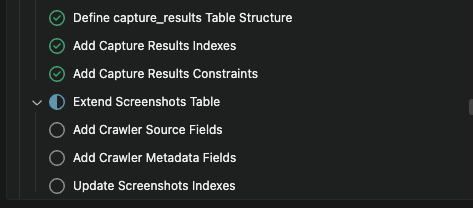 ## Why Tasklist?
Tasklist improves agent effectiveness on long or complex tasks by:
* **Maintaining context** across different conversations by moving your Tasklist to a new chat
* **Breaking down complex problems** into manageable, sequential steps
* **Gathering progress** across threads
* **Exploring alternative solutions** to completed tasks if you need to pivot
* **Streamlining your approach** to nebulous problems by deleting irrelevant steps once the path forward is clear
Tasklist provides a structured interface for collaboration and opens up possibilities for agent-to-agent collaboration. We hypothesize that an interface such as Tasklist could be a preferred way to interact with coding agents in the future.
## Tasklist in Action
## Why Tasklist?
Tasklist improves agent effectiveness on long or complex tasks by:
* **Maintaining context** across different conversations by moving your Tasklist to a new chat
* **Breaking down complex problems** into manageable, sequential steps
* **Gathering progress** across threads
* **Exploring alternative solutions** to completed tasks if you need to pivot
* **Streamlining your approach** to nebulous problems by deleting irrelevant steps once the path forward is clear
Tasklist provides a structured interface for collaboration and opens up possibilities for agent-to-agent collaboration. We hypothesize that an interface such as Tasklist could be a preferred way to interact with coding agents in the future.
## Tasklist in Action
 ## Creating a New Task
### Automatic Creation
The Agent will usually create a Tasklist when it encounters a complex, multi-step problem. You can also ask the Agent to make a Tasklist for you by simply prompting "Start a Tasklist to..." then add the problem you are trying to tackle.
### Manual Creation
You can also manually create a Tasklist:
1. Switch to Tasklist using the checklist button next to Changes
2. Click the plus to add your first task
3. Alternatively, you can create a new task by typing in the gray prompt box at the bottom of the extension. Click **Add Task** from the dropdown arrow next to Send
## Creating a New Task
### Automatic Creation
The Agent will usually create a Tasklist when it encounters a complex, multi-step problem. You can also ask the Agent to make a Tasklist for you by simply prompting "Start a Tasklist to..." then add the problem you are trying to tackle.
### Manual Creation
You can also manually create a Tasklist:
1. Switch to Tasklist using the checklist button next to Changes
2. Click the plus to add your first task
3. Alternatively, you can create a new task by typing in the gray prompt box at the bottom of the extension. Click **Add Task** from the dropdown arrow next to Send
 ## Running Tasks
To run a task, click the grey triangle (play button) next to the task. The Agent will begin executing the task and update its status as it progresses.
## Running Tasks
To run a task, click the grey triangle (play button) next to the task. The Agent will begin executing the task and update its status as it progresses.
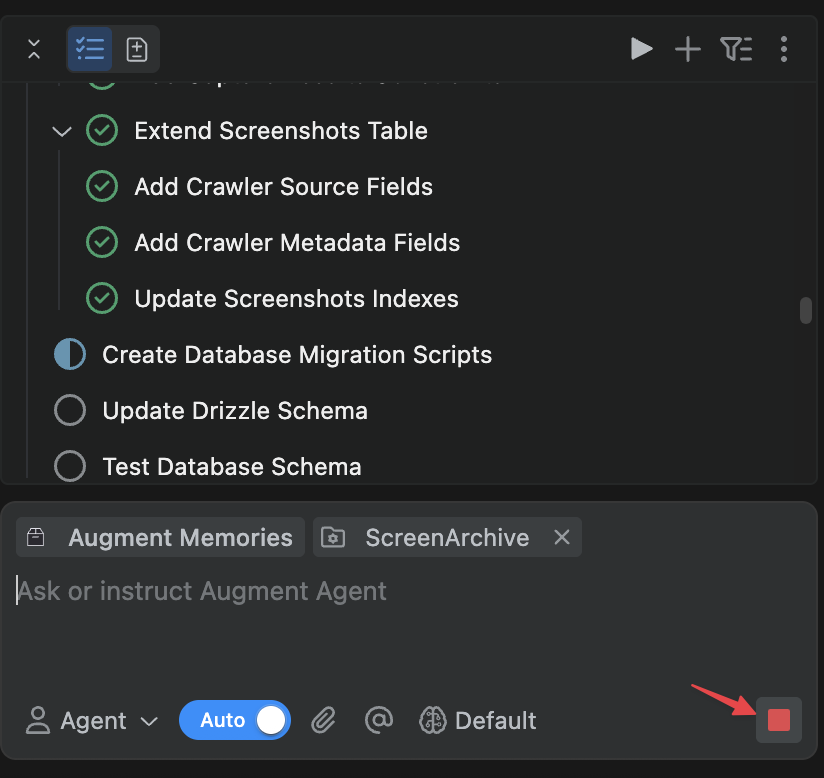 ## Task Status Indicators
Task statuses are indicated by different colors and icons:
* **Empty circle** - Task has not yet started
* **Blue half circle** - Task is currently in progress
* **Green checkbox** - Task has been completed and is ready for review
## Task Status Indicators
Task statuses are indicated by different colors and icons:
* **Empty circle** - Task has not yet started
* **Blue half circle** - Task is currently in progress
* **Green checkbox** - Task has been completed and is ready for review
 ## Subtasks
Augment Code automatically generates subtasks when needed. The Agent will automatically add and nest required subtasks under your initial tasks. You can edit and expand these subtasks just like any other task in the list. Likewise, you can remove subtasks you deem unnecessary.
## Subtasks
Augment Code automatically generates subtasks when needed. The Agent will automatically add and nest required subtasks under your initial tasks. You can edit and expand these subtasks just like any other task in the list. Likewise, you can remove subtasks you deem unnecessary.
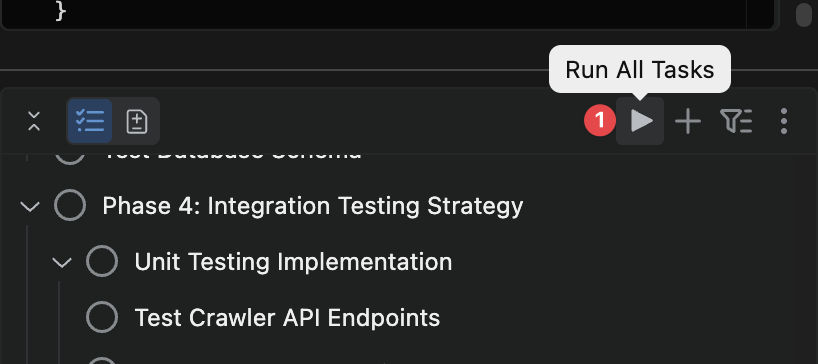 ## Integration with Task Management Tools
### Jira and Linear Integration
The Tasklist is a perfect pairing with existing task management tools like Jira or Linear:
* Ask the Agent to create a Tasklist based on tickets inside Jira or Linear
* Further break down complex tickets into manageable steps
* Once your Tasklist is completed, you can ask the Agent to resolve the issue inside Jira or Linear and append the steps taken as a comment
### Standalone Usage
Don't use an issue tracker? No problem - use Tasklist to track issues you need to tackle across Threads.
## Best Practices
* **Be specific** when creating tasks to help the Agent understand exactly what needs to be done
* **Review and edit** the automatically generated subtasks to ensure they align with your goals
* **Use the stop function** to provide course corrections when the Agent is heading in the wrong direction
* **Leverage the Changes view** to review all modifications made during task execution
* **Move Tasklists** between conversations to maintain context across different chat sessions
## Next Steps
* [Learn more about Agent](/jetbrains/using-augment/agent)
* [Configure Agent Integrations](/jetbrains/setup-augment/agent-integrations)
# Available Models
Source: https://docs.augmentcode.com/models/available-models
The LLMs currently available in Augment and how we use them.
## Current models
Augment uses world-class large language models together with our Context Engine. We currently support the following models:
* Claude Haiku 4.5 by Anthropic
* Claude Opus 4.5 by Anthropic
* Claude Sonnet 4 by Anthropic
* Claude Sonnet 4.5 by Anthropic
* GPT-5.1 by OpenAI
## Choosing a model
You can select the model directly using the Model Picker in the Augment.
* In VS Code and JetBrains, open the Augment panel and use the model dropdown near the input box to switch models.
* In Auggie CLI, use the `/model` slash command or pass the `--model` flag with the desired model.
* Your selection applies only to Agent in that workspace and can be changed at any time.
If you don't pick a model, Augment will use your last selection or the default set by your organization.
## Model pricing
Augment uses a credit-based pricing system. Different models consume credits at different rates based on their capabilities and costs:
* **Sonnet 4.5**: Baseline credit consumption for balanced, complex tasks
* **Opus 4.5**: \~167% of Sonnet's cost - most capable model for the hardest tasks
* **Haiku 4.5**: \~30% of Sonnet's cost - ideal for quick, simple tasks
* **GPT-5.1**: \~75% of Sonnet's cost - great for medium-complexity work
## Integration with Task Management Tools
### Jira and Linear Integration
The Tasklist is a perfect pairing with existing task management tools like Jira or Linear:
* Ask the Agent to create a Tasklist based on tickets inside Jira or Linear
* Further break down complex tickets into manageable steps
* Once your Tasklist is completed, you can ask the Agent to resolve the issue inside Jira or Linear and append the steps taken as a comment
### Standalone Usage
Don't use an issue tracker? No problem - use Tasklist to track issues you need to tackle across Threads.
## Best Practices
* **Be specific** when creating tasks to help the Agent understand exactly what needs to be done
* **Review and edit** the automatically generated subtasks to ensure they align with your goals
* **Use the stop function** to provide course corrections when the Agent is heading in the wrong direction
* **Leverage the Changes view** to review all modifications made during task execution
* **Move Tasklists** between conversations to maintain context across different chat sessions
## Next Steps
* [Learn more about Agent](/jetbrains/using-augment/agent)
* [Configure Agent Integrations](/jetbrains/setup-augment/agent-integrations)
# Available Models
Source: https://docs.augmentcode.com/models/available-models
The LLMs currently available in Augment and how we use them.
## Current models
Augment uses world-class large language models together with our Context Engine. We currently support the following models:
* Claude Haiku 4.5 by Anthropic
* Claude Opus 4.5 by Anthropic
* Claude Sonnet 4 by Anthropic
* Claude Sonnet 4.5 by Anthropic
* GPT-5.1 by OpenAI
## Choosing a model
You can select the model directly using the Model Picker in the Augment.
* In VS Code and JetBrains, open the Augment panel and use the model dropdown near the input box to switch models.
* In Auggie CLI, use the `/model` slash command or pass the `--model` flag with the desired model.
* Your selection applies only to Agent in that workspace and can be changed at any time.
If you don't pick a model, Augment will use your last selection or the default set by your organization.
## Model pricing
Augment uses a credit-based pricing system. Different models consume credits at different rates based on their capabilities and costs:
* **Sonnet 4.5**: Baseline credit consumption for balanced, complex tasks
* **Opus 4.5**: \~167% of Sonnet's cost - most capable model for the hardest tasks
* **Haiku 4.5**: \~30% of Sonnet's cost - ideal for quick, simple tasks
* **GPT-5.1**: \~75% of Sonnet's cost - great for medium-complexity work
Next steps
{children}Visual Studio Code
Install Augment for Visual Studio Code
JetBrains IDEs
Install Augment for JetBrains IDEs, including WebStorm, PyCharm, and IntelliJ

Auggie CLI
All the power of Augment's agent, context engine, and tools in your terminal.
 You'll be redirected to authorize the integration with the appropriate service. After authorization, the integration will be available for use with Augment Agent.
## Native Integrations
##
You'll be redirected to authorize the integration with the appropriate service. After authorization, the integration will be available for use with Augment Agent.
## Native Integrations
## 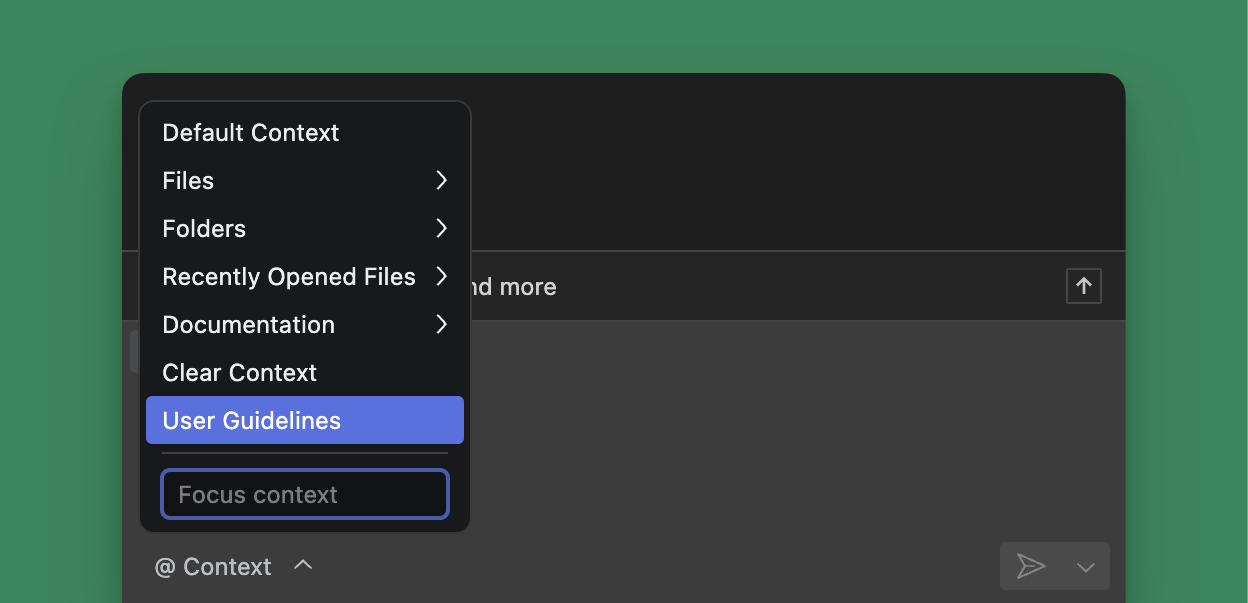 You can add user guidelines by clicking Context menu (@), starting an @-mention inside Chat, or clicking Settings > Rules and User Guidelines.
### Navigating from the Context menu (@) User Guidelines
1. @ mention and select `User Guidelines`
2. Enter your guidelines (see below for tips)
3. Press Escape to save or wait for autosave
### Navigating from Settings > User Guidelines and Rules
You can add user guidelines by clicking Context menu (@), starting an @-mention inside Chat, or clicking Settings > Rules and User Guidelines.
### Navigating from the Context menu (@) User Guidelines
1. @ mention and select `User Guidelines`
2. Enter your guidelines (see below for tips)
3. Press Escape to save or wait for autosave
### Navigating from Settings > User Guidelines and Rules
 1. In the top right corner, select the hamburger menu (⋯)
2. Select Settings
3. From the left menu in Augment Settings, select User Guidelines and Rules
## Working with Rules
You can craft Rules to guide Augment towards specific documentation, frameworks, workflows or workstyles.
Rules are files that live in the `.augment/rules` directory. Currently, we support 3 types of rules:
* **Always**: contents will be included in every user prompt
* **Manual**: needs to be tagged through @ attaching the Rules file manually
* **Auto**: Agent will automatically detect and attach rules based on a description field
### User Rules vs Workspace Rules
Rules can be defined at two levels:
| Scope | Location | Availability |
| :-------- | :--------------------------------- | :---------------------------------- |
| User | `~/.augment/rules/` | Available in all workspaces |
| Workspace | `
1. In the top right corner, select the hamburger menu (⋯)
2. Select Settings
3. From the left menu in Augment Settings, select User Guidelines and Rules
## Working with Rules
You can craft Rules to guide Augment towards specific documentation, frameworks, workflows or workstyles.
Rules are files that live in the `.augment/rules` directory. Currently, we support 3 types of rules:
* **Always**: contents will be included in every user prompt
* **Manual**: needs to be tagged through @ attaching the Rules file manually
* **Auto**: Agent will automatically detect and attach rules based on a description field
### User Rules vs Workspace Rules
Rules can be defined at two levels:
| Scope | Location | Availability |
| :-------- | :--------------------------------- | :---------------------------------- |
| User | `~/.augment/rules/` | Available in all workspaces |
| Workspace | `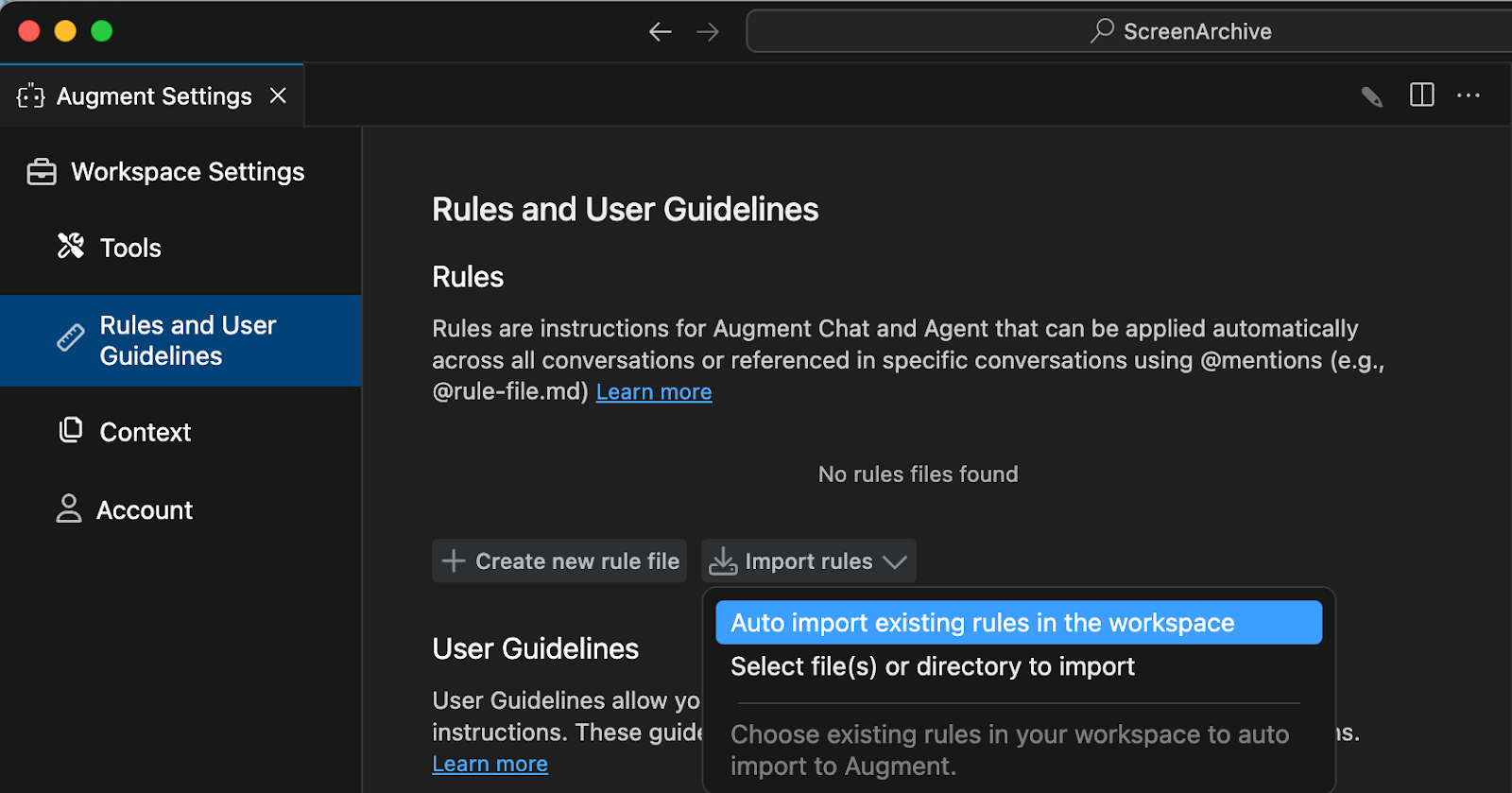 ### Importing Augment Memories into Rules or User Guidelines
Augment Memories are automatically created by the Agent. If you’ve ever modified the Memories or prompted the Agent to remember something you can import these preferences as Rules or User Guidelines.
1. From the prompt box, click on Augment Memories
2. Select the item you'd like to import and then click User Guidelines at the top of Augment Memories from inside the editor.
3. To add the memory as a Rule, you'll first need to add at least one rule using +Create new rule file. Now, you can select any information inside the Augment Memories and save it as a Rule.
### Importing Augment Memories into Rules or User Guidelines
Augment Memories are automatically created by the Agent. If you’ve ever modified the Memories or prompted the Agent to remember something you can import these preferences as Rules or User Guidelines.
1. From the prompt box, click on Augment Memories
2. Select the item you'd like to import and then click User Guidelines at the top of Augment Memories from inside the editor.
3. To add the memory as a Rule, you'll first need to add at least one rule using +Create new rule file. Now, you can select any information inside the Augment Memories and save it as a Rule.
 ## Working with Workspace Guidelines `.augment-guidelines` (legacy)
You can add an `.augment-guidelines` file to the root of a repository to specify a set of guidelines that Augment will follow for all Agent and Chat sessions on the codebase. The `.augment-guidelines` file should be added to your version control system so that everyone working on the codebase has the same guidelines.
### Tips for good rules and guidelines
* Provide guidelines as a list
* Use simple, clear, and concise language for your guidelines
* Asking for shorter or code-only answers may hurt response quality
### Examples
## Working with Workspace Guidelines `.augment-guidelines` (legacy)
You can add an `.augment-guidelines` file to the root of a repository to specify a set of guidelines that Augment will follow for all Agent and Chat sessions on the codebase. The `.augment-guidelines` file should be added to your version control system so that everyone working on the codebase has the same guidelines.
### Tips for good rules and guidelines
* Provide guidelines as a list
* Use simple, clear, and concise language for your guidelines
* Asking for shorter or code-only answers may hurt response quality
### Examples
Next steps
{children} ### 2. Install Slack App
### 2. Install Slack App
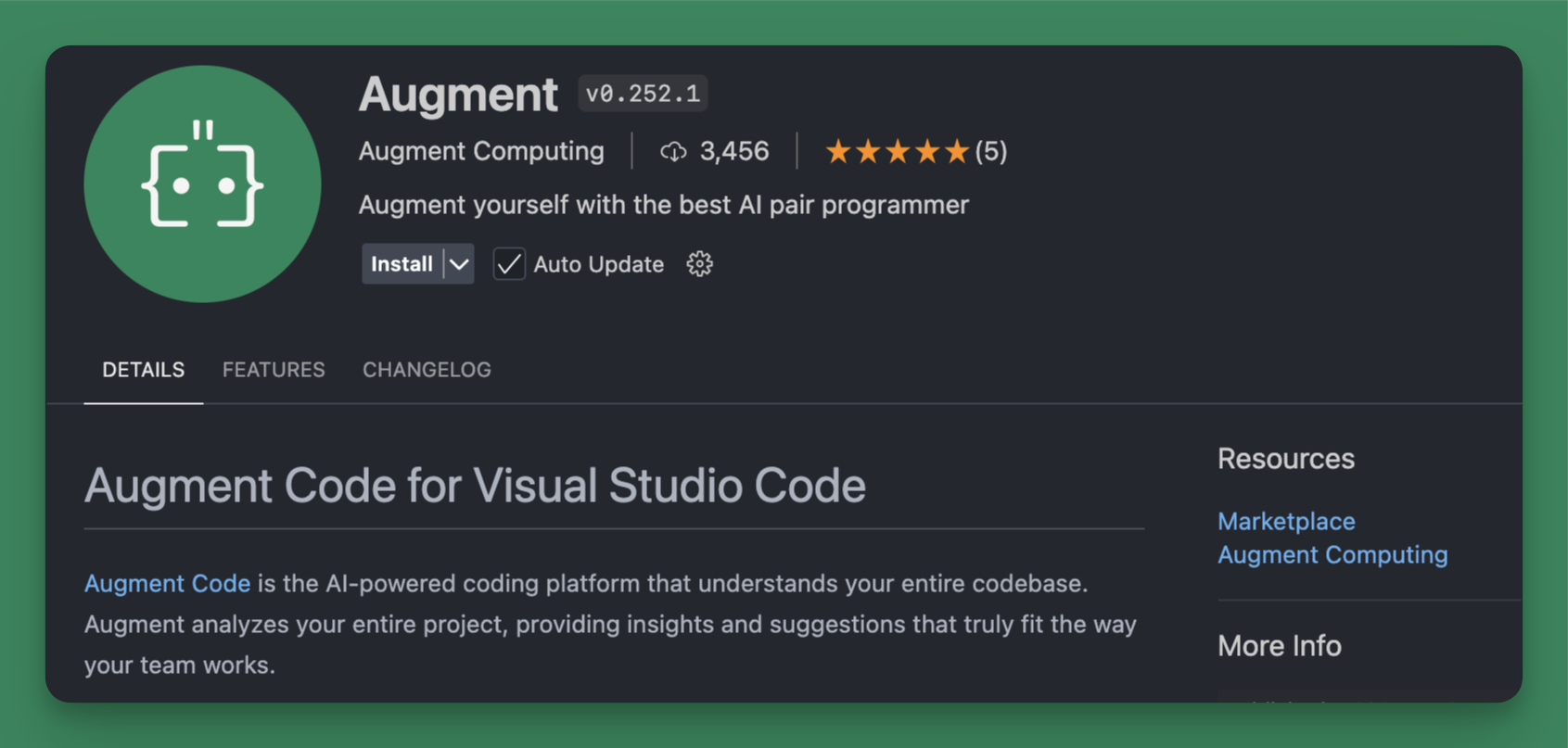 ## Installing Augment for Visual Studio Code
## Installing Augment for Visual Studio Code
 From that moment on, Augment Code streams your tool's live context into every suggestion and autonomous Agent run.
## Advanced MCP Configuration
For developers who need custom MCP server configurations or want to use servers not available through Easy MCP, you can still configure MCP servers manually.
There are three ways to configure MCP servers in Augment:
1. **Easy MCP** (recommended) - One-click integrations for popular tools
2. **Augment Settings Panel** - Manual configuration with a GUI
3. **Import from JSON** - Paste a JSON config to quickly add servers
MCP servers configured through the Settings Panel or Import from JSON are managed in the same place. After importing, you can edit or remove servers in the Settings Panel.
## Configure in the Augment Settings Panel
The easiest way to configure MCP servers is to use the Augment Settings Panel.
To access the settings panel, open the options menu in the upper right of the Augment panel and click the Settings option. Once the settings panel is open, you will see a section for MCP servers.
From that moment on, Augment Code streams your tool's live context into every suggestion and autonomous Agent run.
## Advanced MCP Configuration
For developers who need custom MCP server configurations or want to use servers not available through Easy MCP, you can still configure MCP servers manually.
There are three ways to configure MCP servers in Augment:
1. **Easy MCP** (recommended) - One-click integrations for popular tools
2. **Augment Settings Panel** - Manual configuration with a GUI
3. **Import from JSON** - Paste a JSON config to quickly add servers
MCP servers configured through the Settings Panel or Import from JSON are managed in the same place. After importing, you can edit or remove servers in the Settings Panel.
## Configure in the Augment Settings Panel
The easiest way to configure MCP servers is to use the Augment Settings Panel.
To access the settings panel, open the options menu in the upper right of the Augment panel and click the Settings option. Once the settings panel is open, you will see a section for MCP servers.
 Fill in the `name` and `command` fields. The `name` field must be a unique name for the server. The `command` field is the command to run the server. Environment variables have their own section and no longer need to be specified in the command.
Fill in the `name` and `command` fields. The `name` field must be a unique name for the server. The `command` field is the command to run the server. Environment variables have their own section and no longer need to be specified in the command.
 To add additional servers, click the `+` button next to the `MCP` header.
To edit a configuration, or to delete a server, click the `...` button next to the server name.
### Add a Remote MCP server
If your MCP server runs remotely (for example, a hosted service), click the "+ Add remote MCP" button in the MCP section. Remote MCP connections support both HTTP and SSE (Server‑Sent Events).
To add additional servers, click the `+` button next to the `MCP` header.
To edit a configuration, or to delete a server, click the `...` button next to the server name.
### Add a Remote MCP server
If your MCP server runs remotely (for example, a hosted service), click the "+ Add remote MCP" button in the MCP section. Remote MCP connections support both HTTP and SSE (Server‑Sent Events).
 * Connection Type: choose HTTP or SSE
* Name: a unique display name for the server
* URL: the base URL to your MCP server (e.g., [https://api.example.com](https://api.example.com))
Remote MCP servers appear alongside your local MCP servers in the list. You can edit or remove them using the "..." menu next to the server name.
## Import from JSON
You can quickly add MCP servers by importing a JSON configuration from the Augment Settings Panel:
1. Open the Settings Panel (gear icon in the Augment panel)
2. In the MCP section, click Import from JSON
3. Paste a configuration like the following and click Save
* Connection Type: choose HTTP or SSE
* Name: a unique display name for the server
* URL: the base URL to your MCP server (e.g., [https://api.example.com](https://api.example.com))
Remote MCP servers appear alongside your local MCP servers in the list. You can edit or remove them using the "..." menu next to the server name.
## Import from JSON
You can quickly add MCP servers by importing a JSON configuration from the Augment Settings Panel:
1. Open the Settings Panel (gear icon in the Augment panel)
2. In the MCP section, click Import from JSON
3. Paste a configuration like the following and click Save
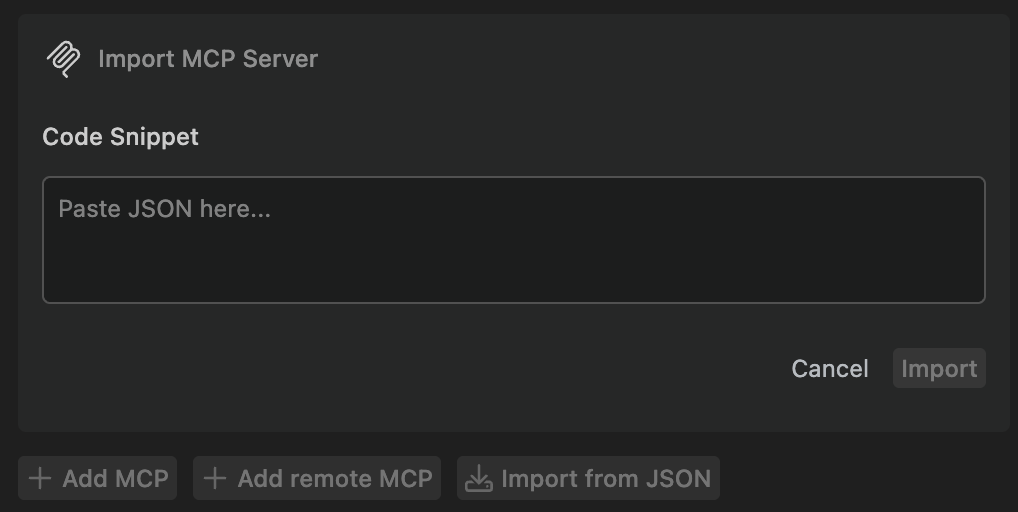 **Example: Local command (Context7 via npx)**
```json theme={null}
{
"mcpServers": {
"Context7": {
"command": "npx",
"args": ["-y", "@upstash/context7-mcp"]
}
}
}
```
**Example: Remote SSE endpoint**
```json theme={null}
{
"mcpServers": {
"test": {
"url": "http://localhost:3001/sse",
"type": "sse"
}
}
}
```
After importing, servers appear in the list where you can edit, test, or remove them. Ensure any required dependencies for the server are installed on your machine.
## Server compatibility
Not all MCP servers are compatible with Augment's models. The MCP standard, implementation of specific servers, and Augment's MCP support are frequently being updated, so check compatibility frequently.
# Sign in and out
Source: https://docs.augmentcode.com/setup-augment/sign-in
After you have installed the Augment extension, you will need to sign in to your account.
export const MoreVertIcon = () =>
**Example: Local command (Context7 via npx)**
```json theme={null}
{
"mcpServers": {
"Context7": {
"command": "npx",
"args": ["-y", "@upstash/context7-mcp"]
}
}
}
```
**Example: Remote SSE endpoint**
```json theme={null}
{
"mcpServers": {
"test": {
"url": "http://localhost:3001/sse",
"type": "sse"
}
}
}
```
After importing, servers appear in the list where you can edit, test, or remove them. Ensure any required dependencies for the server are installed on your machine.
## Server compatibility
Not all MCP servers are compatible with Augment's models. The MCP standard, implementation of specific servers, and Augment's MCP support are frequently being updated, so check compatibility frequently.
# Sign in and out
Source: https://docs.augmentcode.com/setup-augment/sign-in
After you have installed the Augment extension, you will need to sign in to your account.
export const MoreVertIcon = () =>
Availability
{tags.map(tag =>
{tag}
)}
;
};
Availability
{tags.map(tag =>
{tag}
)}
;
};
export const Command = ({text}) => {text};
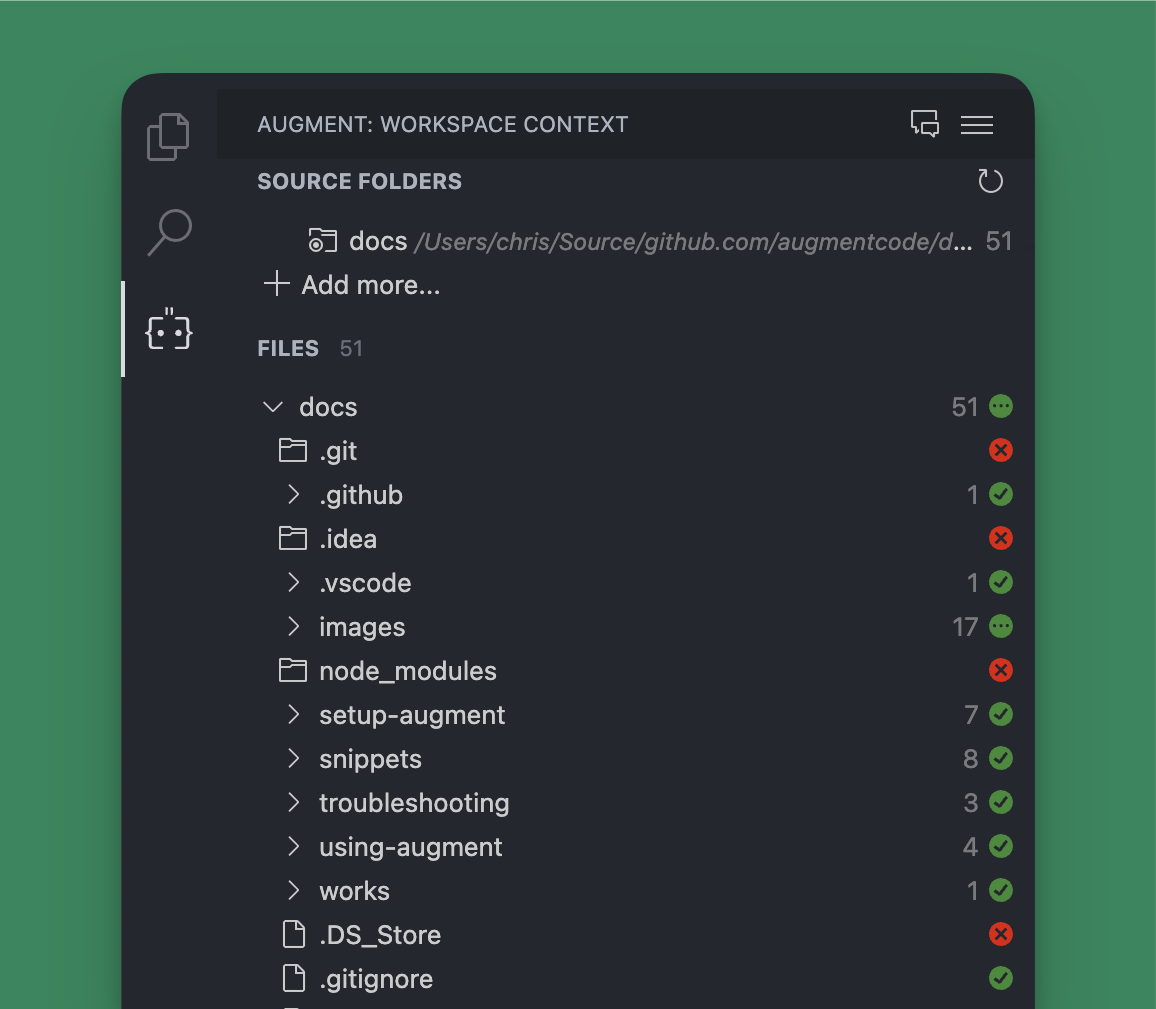 ## Add context to your workspace
To add context to your workspace, click
## Add context to your workspace
To add context to your workspace, click `-- Request ID: 7f67c0dd-4c80-4167-9383-8013b18836cb`
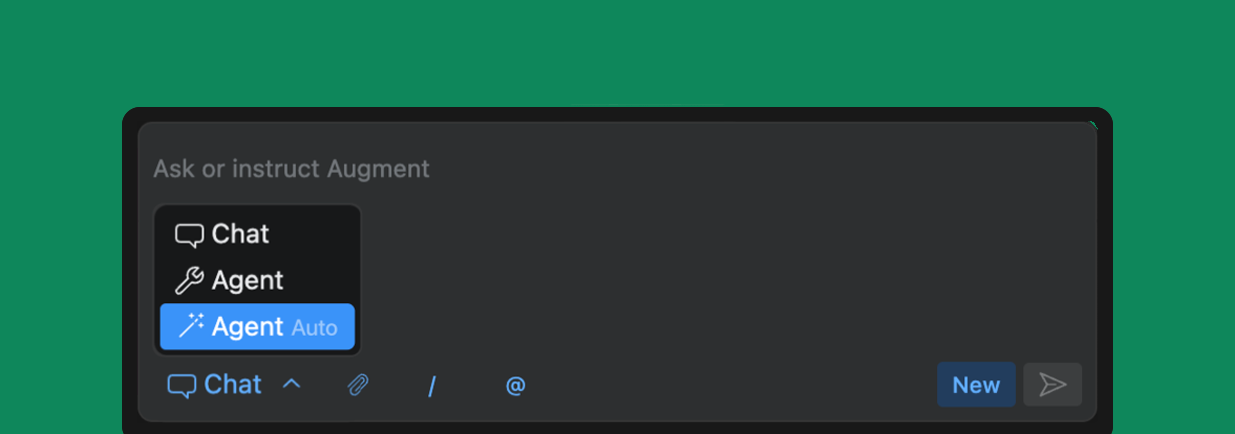 ### Choosing a model
Use the model dropdown in the Augment panel to switch between models. Your selection applies only to Agent for the current workspace and can be changed at any time. See [Available Models](/models/available-models) for details.
## Using Agent
To use Agent, simply type your request into the input box using natural language and click the submit button. You will see the default context including current workspace, current file, and Agent memories. You can add additional context by clicking
### Choosing a model
Use the model dropdown in the Augment panel to switch between models. Your selection applies only to Agent for the current workspace and can be changed at any time. See [Available Models](/models/available-models) for details.
## Using Agent
To use Agent, simply type your request into the input box using natural language and click the submit button. You will see the default context including current workspace, current file, and Agent memories. You can add additional context by clicking 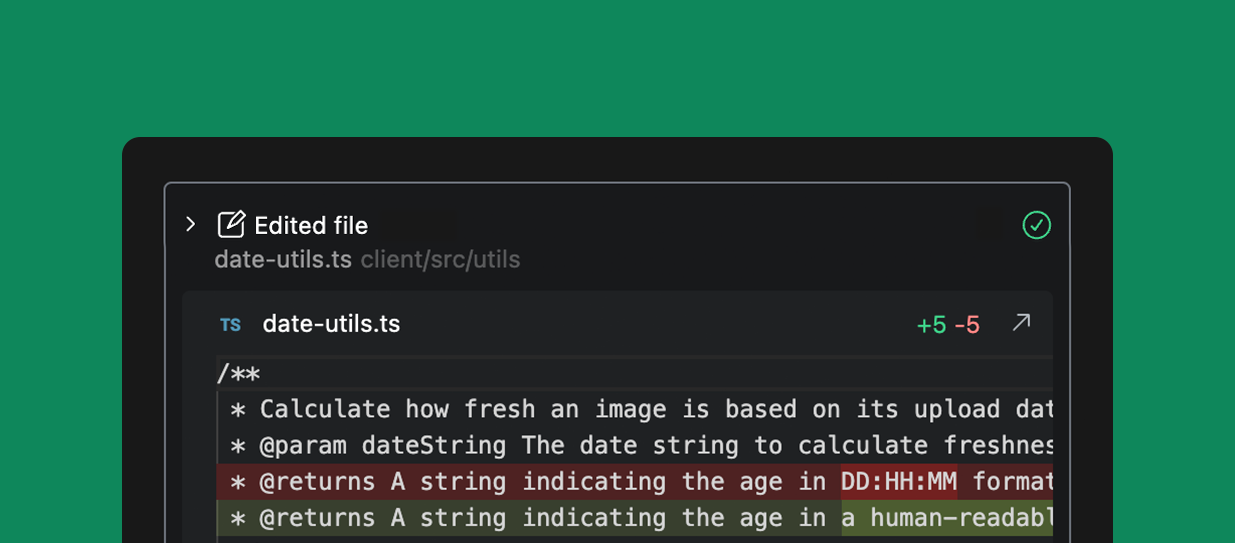 ### Checkpoints
Checkpoints are automatically saved snapshots of your workspace as Agent implements the plan allowing you to easily revert back to a previous step. This enables Agent to continue working while you review code changes and commands results. To revert to a previous checkpoint, click the reverse arrow icon to restore your code.
### Checkpoints
Checkpoints are automatically saved snapshots of your workspace as Agent implements the plan allowing you to easily revert back to a previous step. This enables Agent to continue working while you review code changes and commands results. To revert to a previous checkpoint, click the reverse arrow icon to restore your code.
 ### Agent memories
Memories help the Agent remember important details about your workspace and your preferences for working in it. Memories are stored locally and are applied to all Agent requests. Memories can be added automatically by Agent, by clicking the remember button under a message, asking Agent to remember something, or by editing the Memories files directly.
### Agent memories
Memories help the Agent remember important details about your workspace and your preferences for working in it. Memories are stored locally and are applied to all Agent requests. Memories can be added automatically by Agent, by clicking the remember button under a message, asking Agent to remember something, or by editing the Memories files directly.
 ### Agent vs Agent Auto
By default, Agent will pause work when it needs to execute a terminal command or access external integrations. After reviewing the suggested action, click the blue play button to have Agent execute the command and continue working. You tell Agent to skip a specific action by clicking on the three dots and then Skip.
### Agent vs Agent Auto
By default, Agent will pause work when it needs to execute a terminal command or access external integrations. After reviewing the suggested action, click the blue play button to have Agent execute the command and continue working. You tell Agent to skip a specific action by clicking on the three dots and then Skip.
 In Agent Auto, Agent will act more independently. It will edit files, execute terminal commands, and access tools like MCP servers automatically.
### Stop or guide the Agent
You can interrupt the Agent at any time by clicking Stop. This will pause the action to allow you to correct something you see the agent doing incorrectly. While Agent is working, you can also prompt the Agent to try a different approach which will automatically stop the agent and prompt it to correct its course.
In Agent Auto, Agent will act more independently. It will edit files, execute terminal commands, and access tools like MCP servers automatically.
### Stop or guide the Agent
You can interrupt the Agent at any time by clicking Stop. This will pause the action to allow you to correct something you see the agent doing incorrectly. While Agent is working, you can also prompt the Agent to try a different approach which will automatically stop the agent and prompt it to correct its course.
 ### Quick Ask Mode
Quick Ask Mode is a toggle button in the agent chat interface that restricts the AI to read-only tools only. When activated, it adds a visual badge to the message and focuses the AI on information gathering without making any changes to your codebase.
### Quick Ask Mode
Quick Ask Mode is a toggle button in the agent chat interface that restricts the AI to read-only tools only. When activated, it adds a visual badge to the message and focuses the AI on information gathering without making any changes to your codebase.
 ### Comparison to Chat
Agent takes Chat to the next level by allowing Augment to do things for you-that is create and make modifications directly to your codebase. Chat can explain code, create plans, and suggest changes which you can smartly apply one-by-one, but Agent takes it a step further by automatically implementing the entire plan and all code changes for you.
| What are you trying to do? | Chat | Agent |
| :----------------------------------------------- | :--: | :---: |
| Ask questions about your code | ☑️ | ✅ |
| Get advice on how to refactor code | ☑️ | ✅ |
| Add new features to selected lines of code | ☑️ | ✅ |
| Add new feature spanning multiple files | | ✅ |
| Document new features | | ✅ |
| Queue up tests for you in the terminal | | ✅ |
| Open Linear tickets or start a pull request | | ✅ |
| Start a new branch in GitHub from recent commits | | ✅ |
| Automatically perform tasks on your behalf | | ✅ |
### Use cases
Use Agent to handle various aspects of your software development workflow, from simple configuration changes to complex feature implementations. Agent supports your daily engineering tasks like:
* **Make quick edits** - Create a pull request to adjust configuration values like feature flags from FALSE to TRUE
* **Perform refactoring** - Move functions between files while maintaining coding conventions and ensuring bug-free operation
* **Start a first draft for new features** - Start a pull request (PR) with implementing entirely new functionality straight from a GitHub Issue or Linear Ticket
* **Branch from GitHub** - Open a PR from GitHub based on recent commits that creates a new branch
* **Query Supabase tables directly** - Ask Agent to view the contents of a table
* **Start tickets in Linear or Jira** - Open tickets and ask Agent to suggest a plan to address the ticket
* **Add Pull Request descriptions** - Merge your PR into a branch then tell the agent to explain what the changes are and why they were made
* **Create test coverage** - Generate unit tests for your newly developed features
* **Generate documentation** - Produce comprehensive documentation for your libraries and features
* **Start a README** - Write a README for a new feature or updated function that you just wrote
* **Track development progress** - Review and summarize your recent Git commits for better visibility with the GitHub integration
## Next steps
* [Configure Agent Integrations](/setup-augment/agent-integrations)
* [Configure other tools with MCP](/setup-augment/mcp)
# Using Chat
Source: https://docs.augmentcode.com/using-augment/chat
Use Chat to explore your codebase, quickly get up to speed on unfamiliar code, and get help working through a technical problem.
export const type_0 = "chats"
export const DeleteIcon = () =>
### Comparison to Chat
Agent takes Chat to the next level by allowing Augment to do things for you-that is create and make modifications directly to your codebase. Chat can explain code, create plans, and suggest changes which you can smartly apply one-by-one, but Agent takes it a step further by automatically implementing the entire plan and all code changes for you.
| What are you trying to do? | Chat | Agent |
| :----------------------------------------------- | :--: | :---: |
| Ask questions about your code | ☑️ | ✅ |
| Get advice on how to refactor code | ☑️ | ✅ |
| Add new features to selected lines of code | ☑️ | ✅ |
| Add new feature spanning multiple files | | ✅ |
| Document new features | | ✅ |
| Queue up tests for you in the terminal | | ✅ |
| Open Linear tickets or start a pull request | | ✅ |
| Start a new branch in GitHub from recent commits | | ✅ |
| Automatically perform tasks on your behalf | | ✅ |
### Use cases
Use Agent to handle various aspects of your software development workflow, from simple configuration changes to complex feature implementations. Agent supports your daily engineering tasks like:
* **Make quick edits** - Create a pull request to adjust configuration values like feature flags from FALSE to TRUE
* **Perform refactoring** - Move functions between files while maintaining coding conventions and ensuring bug-free operation
* **Start a first draft for new features** - Start a pull request (PR) with implementing entirely new functionality straight from a GitHub Issue or Linear Ticket
* **Branch from GitHub** - Open a PR from GitHub based on recent commits that creates a new branch
* **Query Supabase tables directly** - Ask Agent to view the contents of a table
* **Start tickets in Linear or Jira** - Open tickets and ask Agent to suggest a plan to address the ticket
* **Add Pull Request descriptions** - Merge your PR into a branch then tell the agent to explain what the changes are and why they were made
* **Create test coverage** - Generate unit tests for your newly developed features
* **Generate documentation** - Produce comprehensive documentation for your libraries and features
* **Start a README** - Write a README for a new feature or updated function that you just wrote
* **Track development progress** - Review and summarize your recent Git commits for better visibility with the GitHub integration
## Next steps
* [Configure Agent Integrations](/setup-augment/agent-integrations)
* [Configure other tools with MCP](/setup-augment/mcp)
# Using Chat
Source: https://docs.augmentcode.com/using-augment/chat
Use Chat to explore your codebase, quickly get up to speed on unfamiliar code, and get help working through a technical problem.
export const type_0 = "chats"
export const DeleteIcon = () =>  ## Accessing Chat
Access the Chat sidebar by clicking the Augment icon
## Accessing Chat
Access the Chat sidebar by clicking the Augment icon  ## Using actions in Chat
To use a quick action, you an use a
## Using actions in Chat
To use a quick action, you an use a  ## Using code blocks from within Chat
Whenever Chat responds with code, you will have the option to add the code to your codebase. The most common option will be shown as a button and you can access the other options by clicking the overflow menu icon
## Using code blocks from within Chat
Whenever Chat responds with code, you will have the option to add the code to your codebase. The most common option will be shown as a button and you can access the other options by clicking the overflow menu icon
Availability
{tags.map(tag =>
{tag}
)}
;
};
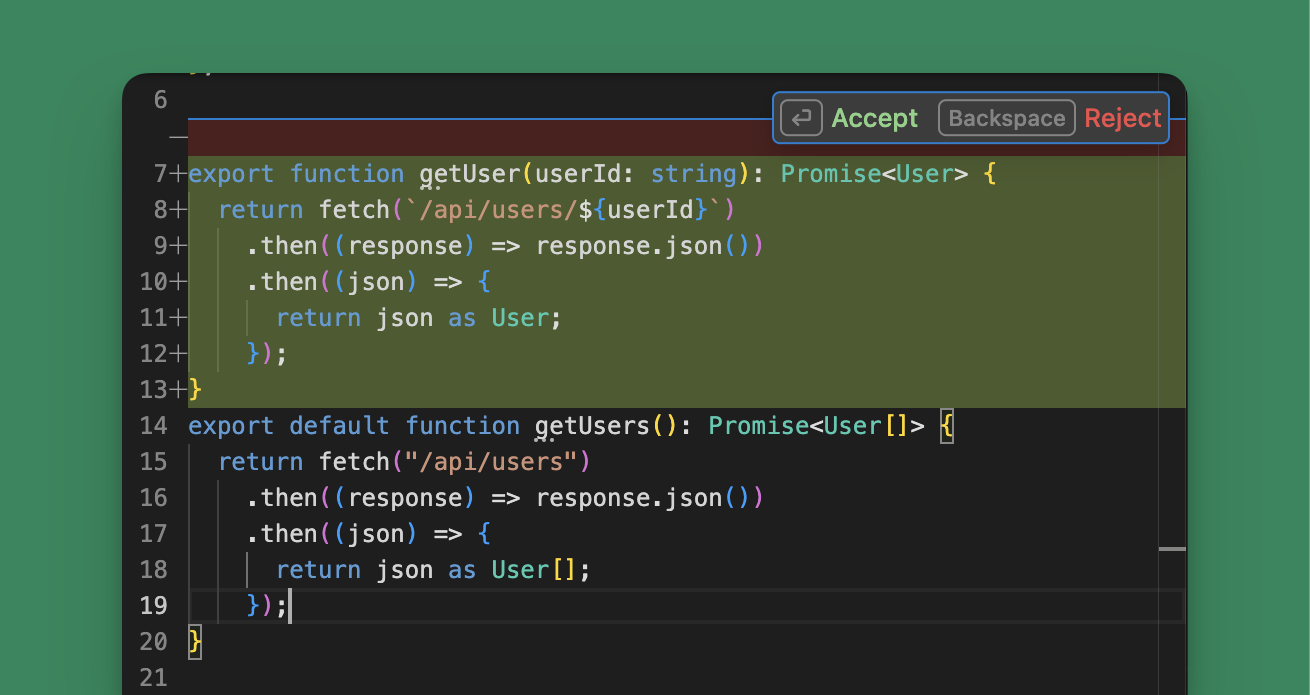 Your change will be made as a diff, so you can review the suggested updates before modifying your code. Use the following shortcuts or click the options in the UI to accept or reject the changes.
Your change will be made as a diff, so you can review the suggested updates before modifying your code. Use the following shortcuts or click the options in the UI to accept or reject the changes.
Availability
{tags.map(tag =>
{tag}
)}
;
};
export const Command = ({text}) => {text};
export const Keyboard = ({shortcut}) =>
{shortcut}
;
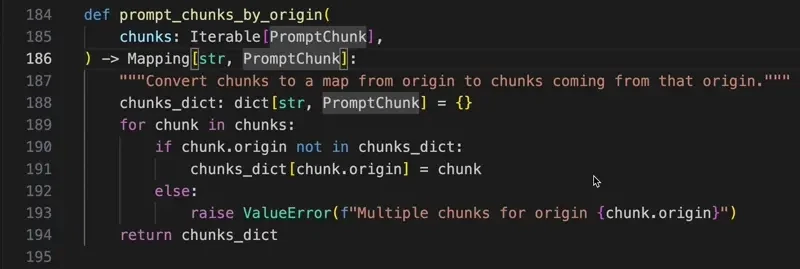 When Next Edit has a suggestion available, you will see a gutter icon and a summary
of the change in gray at the end of the line.
To jump to the next suggestion, press
When Next Edit has a suggestion available, you will see a gutter icon and a summary
of the change in gray at the end of the line.
To jump to the next suggestion, press 
 By default, Next Edit will briefly highlight which parts of the existing code will
change before applying the change and highlighting the new code. Use Undo
(
By default, Next Edit will briefly highlight which parts of the existing code will
change before applying the change and highlighting the new code. Use Undo
(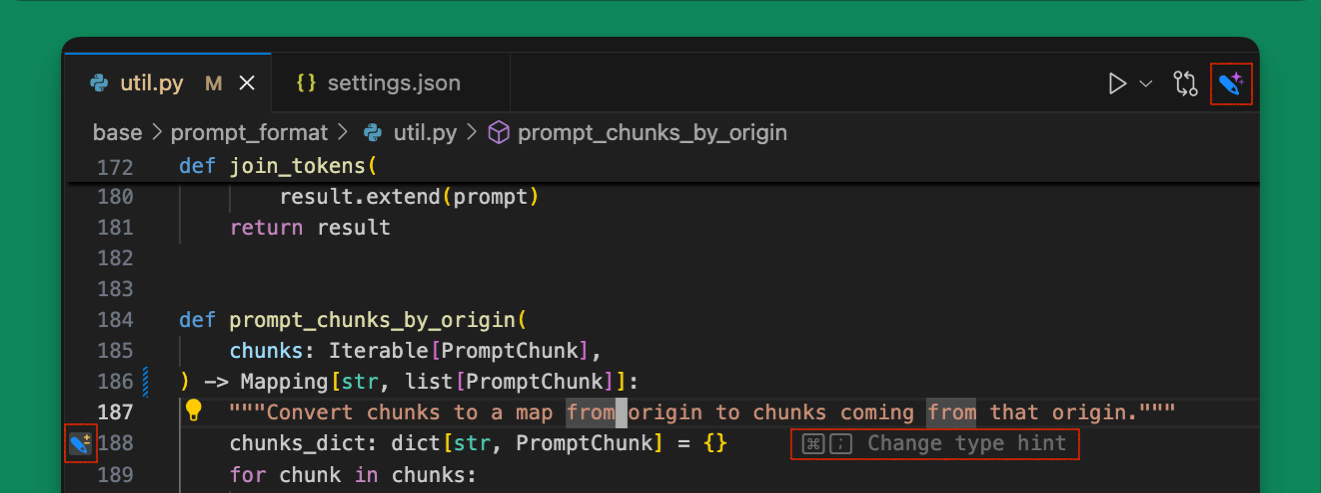 1. **Editor Title Icon** (Top Right): Changes colors when next edits are available.
Click on the
1. **Editor Title Icon** (Top Right): Changes colors when next edits are available.
Click on the  4. **Hint Box** (Bottom Left) - appears when the next suggestion is off screen with
brief summary of the change and the keybinding to press (typically
4. **Hint Box** (Bottom Left) - appears when the next suggestion is off screen with
brief summary of the change and the keybinding to press (typically
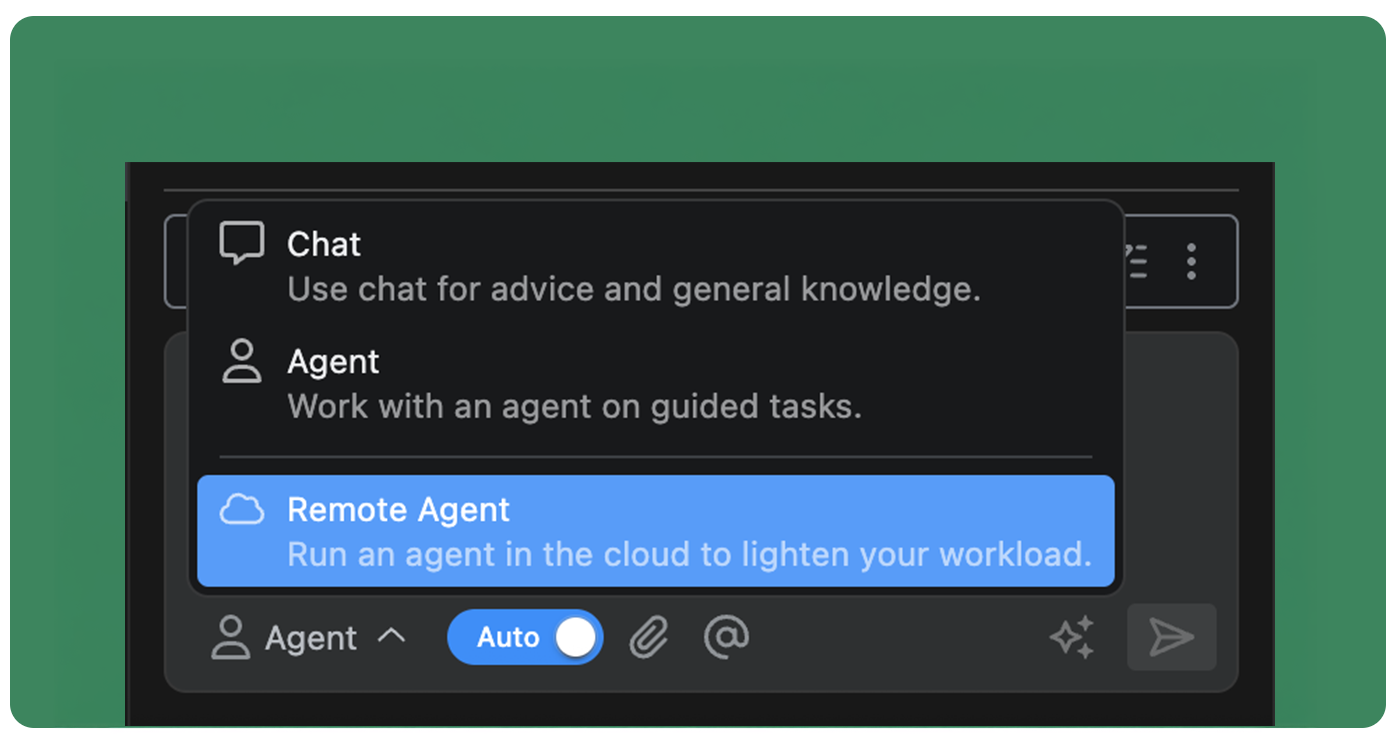 ### Agent dashboard
You can view all of your remote agents in the Remote Agent dashboard by clicking the
### Agent dashboard
You can view all of your remote agents in the Remote Agent dashboard by clicking the  ## Using Remote Agent
Remote Agents function nearly identically to IDE-bound agents as you work through your tasks and projects. Because they run asynchronously in the cloud, you can access and manage them while working on other projects in your editor. Access your Remote Agents from the threads menu at the top of the Augment panel or through the Remote Agent dashboard.
You can create and manage a Remote Agent for any repository you have access to through GitHub regardless of which project you are currently working on in your editor.
### Create a remote agent
## Using Remote Agent
Remote Agents function nearly identically to IDE-bound agents as you work through your tasks and projects. Because they run asynchronously in the cloud, you can access and manage them while working on other projects in your editor. Access your Remote Agents from the threads menu at the top of the Augment panel or through the Remote Agent dashboard.
You can create and manage a Remote Agent for any repository you have access to through GitHub regardless of which project you are currently working on in your editor.
### Create a remote agent
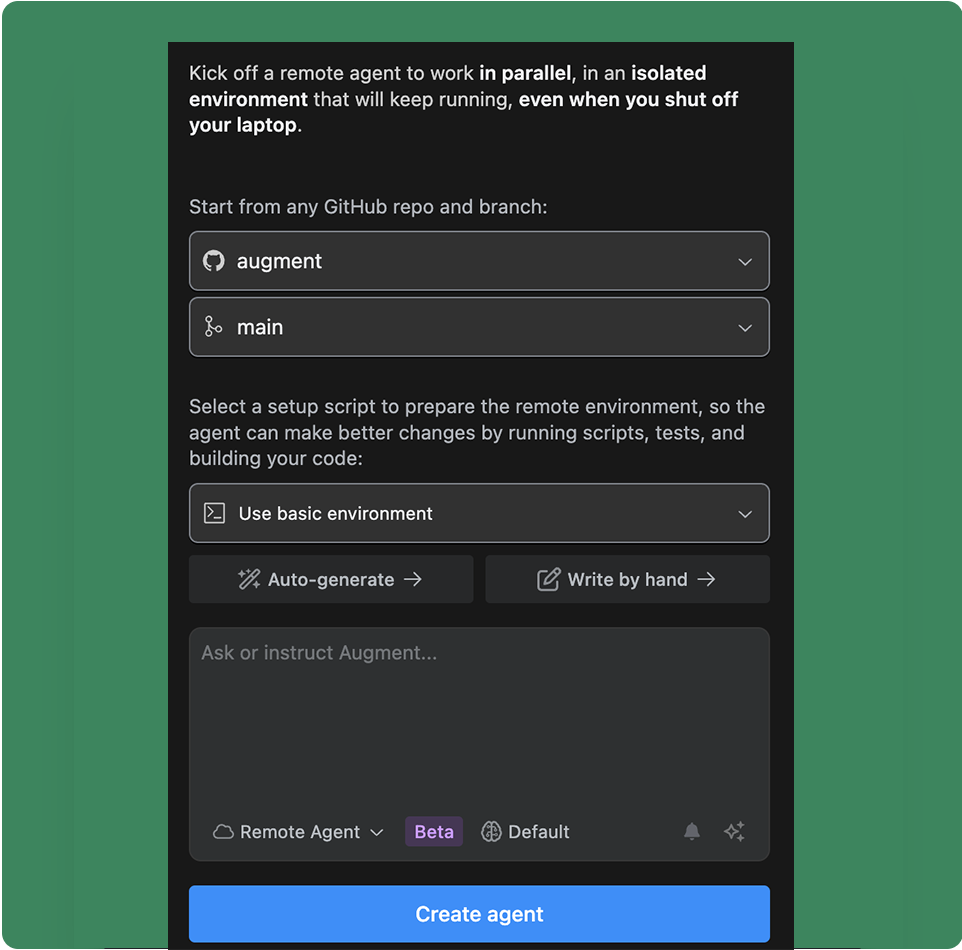 #### Agent environment
Each Remote Agent runs in an secure, independent environment in the cloud. This enables each agent to have its own workspace, copy of the repository, and virtualized operating system to run other tools and commands. You can use the [base environment](/using-augment/remote-agent-environment#base-environment), or setup a custom environment using a bash script to configure the tools the agent will need to complete the task.
See [Remote Agent Environment](/using-augment/remote-agent-environment) for more details on customizing the agent environment.
### Agent notifications
By default, you will receive a notification in VS Code when the agent has completed a task or needs your attention. You can disable notifications for a remote agent by clicking the bell icon in the theads list of the Augment panel.
### Iterating with an agent
Once an agent has completed the task, you can continue to iterate with the agent by sending additional messages. The agent will continue to work on the task, using its past conversations as context. If you need to switch to editing files directly, you can connect to the agent environment over SSH. See [Connecting to a Remote Agent](#connecting-to-a-remote-agent-environment) for more details.
### Reviewing changes
You can review every change Agent makes by clicking on the action to expand the view. Review diffs for file changes, see complete terminal commands and output, and the results of external integration calls.
#### Agent environment
Each Remote Agent runs in an secure, independent environment in the cloud. This enables each agent to have its own workspace, copy of the repository, and virtualized operating system to run other tools and commands. You can use the [base environment](/using-augment/remote-agent-environment#base-environment), or setup a custom environment using a bash script to configure the tools the agent will need to complete the task.
See [Remote Agent Environment](/using-augment/remote-agent-environment) for more details on customizing the agent environment.
### Agent notifications
By default, you will receive a notification in VS Code when the agent has completed a task or needs your attention. You can disable notifications for a remote agent by clicking the bell icon in the theads list of the Augment panel.
### Iterating with an agent
Once an agent has completed the task, you can continue to iterate with the agent by sending additional messages. The agent will continue to work on the task, using its past conversations as context. If you need to switch to editing files directly, you can connect to the agent environment over SSH. See [Connecting to a Remote Agent](#connecting-to-a-remote-agent-environment) for more details.
### Reviewing changes
You can review every change Agent makes by clicking on the action to expand the view. Review diffs for file changes, see complete terminal commands and output, and the results of external integration calls.
 ### Stop or guide the Agent
You can interrupt the Agent at any time by clicking Stop. This will pause the action to allow you to correct something you see the agent doing incorrectly. While Agent is working, you can also prompt the Agent to try a different approach which will automatically stop the agent and prompt it to correct its course.
### Stop or guide the Agent
You can interrupt the Agent at any time by clicking Stop. This will pause the action to allow you to correct something you see the agent doing incorrectly. While Agent is working, you can also prompt the Agent to try a different approach which will automatically stop the agent and prompt it to correct its course.
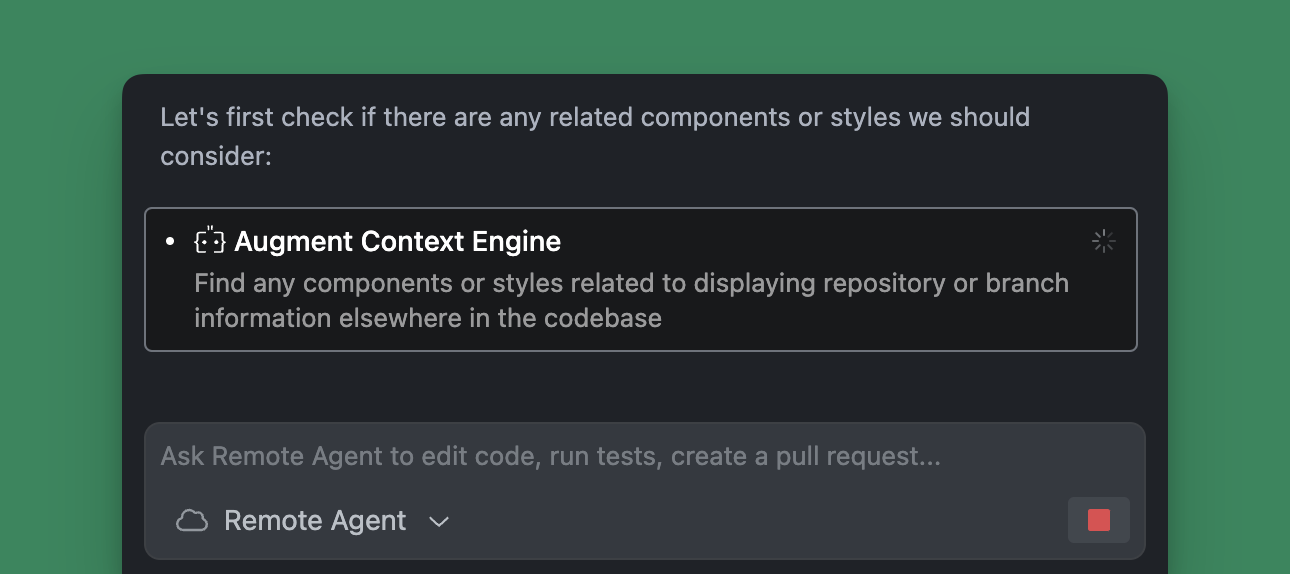 ### Connecting to a Remote Agent environment
### Connecting to a Remote Agent environment
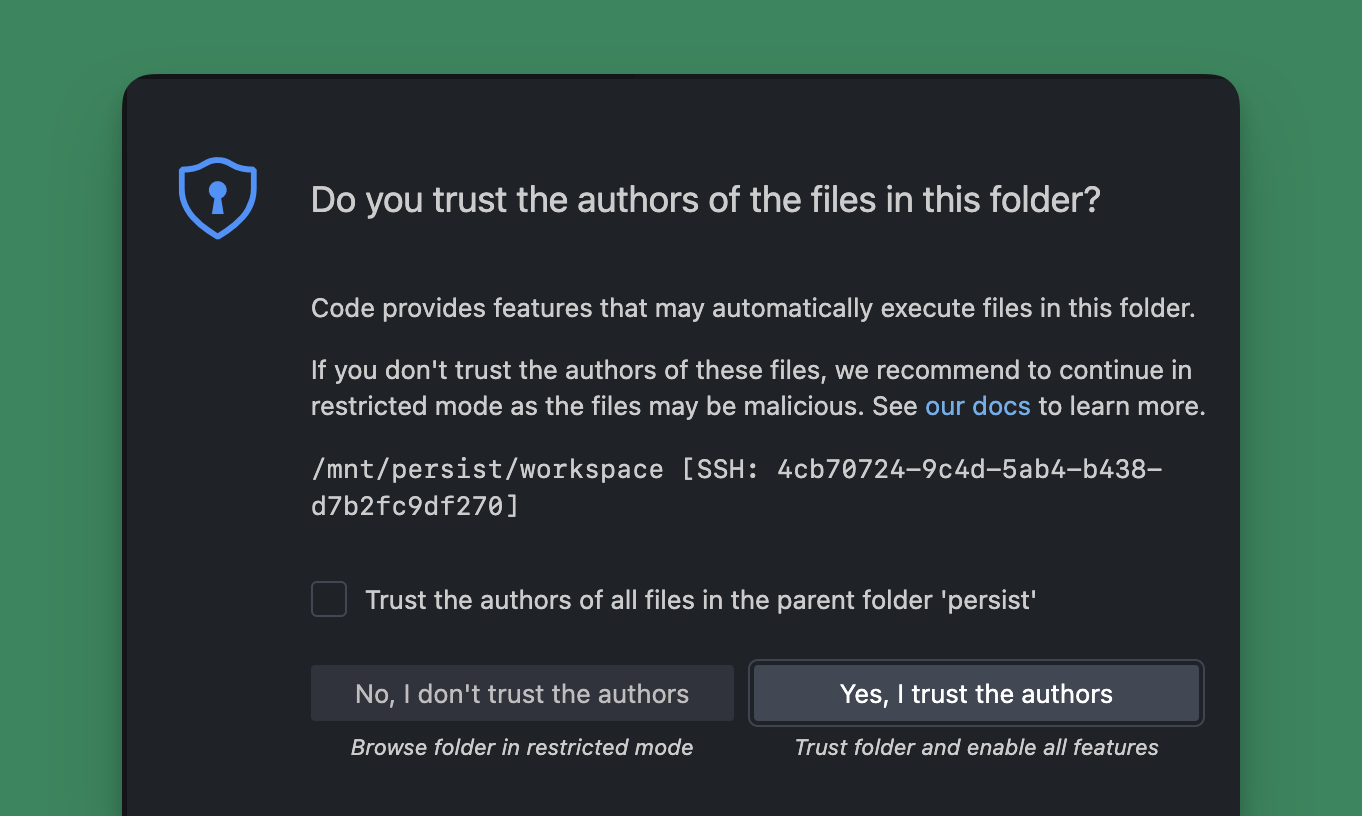 You can use the new VS Code window to view and edit files, run commands in the terminal, and generally interact with the agent just like you would a local IDE-bound agent.
### Opening a Pull Request
When the agent has completed the work, you can open a pull request to have your changes opened for review and merging into the main branch. Select the agent from the threads list and click
You can use the new VS Code window to view and edit files, run commands in the terminal, and generally interact with the agent just like you would a local IDE-bound agent.
### Opening a Pull Request
When the agent has completed the work, you can open a pull request to have your changes opened for review and merging into the main branch. Select the agent from the threads list and click 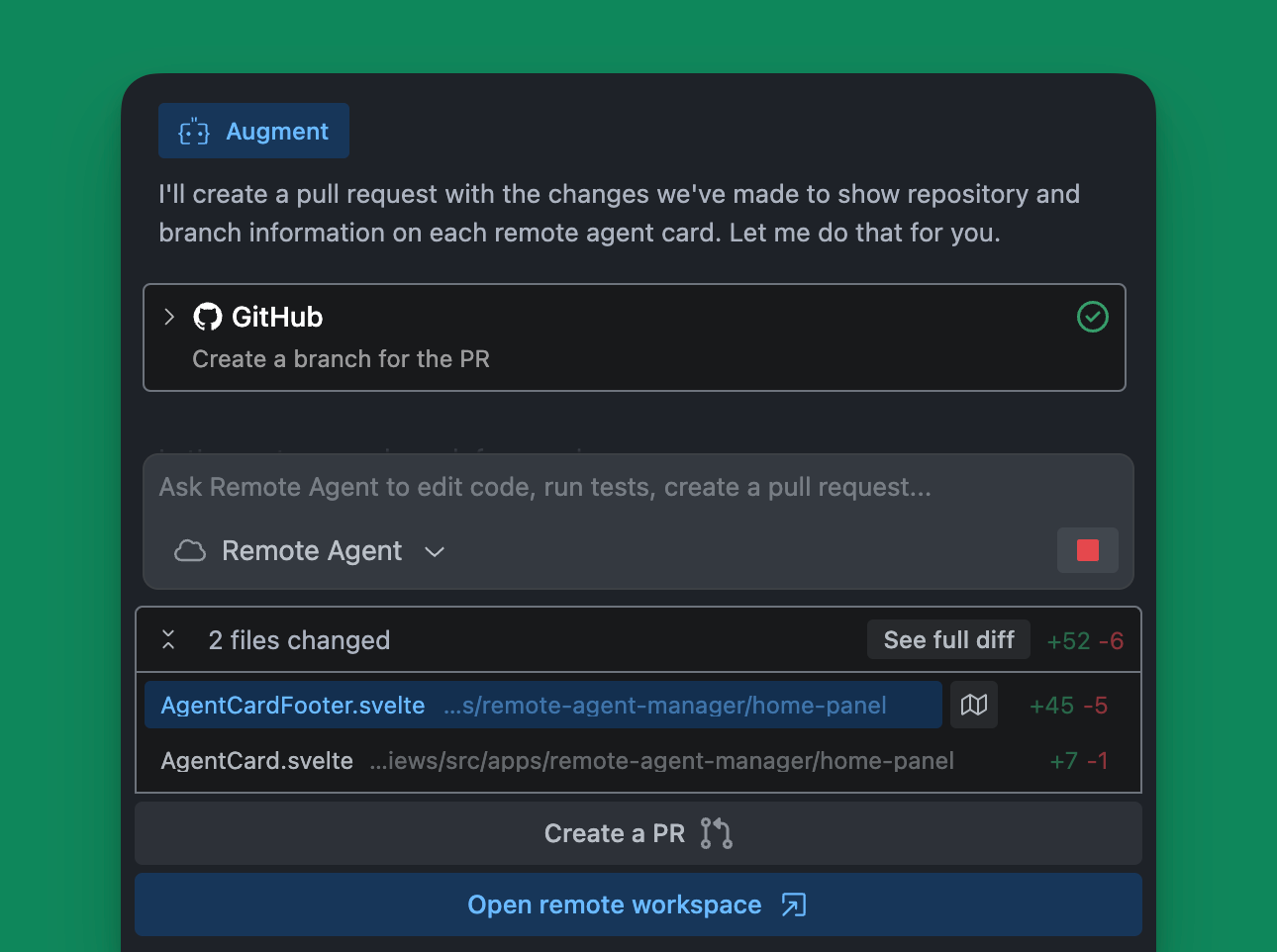 ### Resuming a Remote Agent
Remote Agents automatically pause after completing a request or remaining idle for a period of time. To resume a paused Remote Agent, either click
### Resuming a Remote Agent
Remote Agents automatically pause after completing a request or remaining idle for a period of time. To resume a paused Remote Agent, either click  ## Adding Augment to Channels
Mention
## Adding Augment to Channels
Mention  ## Getting started with Tasklist?
Tasklist improves agent effectiveness on long or complex tasks by:
* **Maintaining context** across different conversations by moving your Tasklist to a new chat
* **Breaking down complex problems** into manageable, sequential steps
* **Gathering progress** across threads
* **Exploring alternative solutions** to completed tasks if you need to pivot
* **Streamlining your approach** to nebulous problems by deleting irrelevant steps once the path forward is clear
Tasklist provides a structured interface for collaboration and opens up possibilities for agent-to-agent collaboration. We hypothesize that an interface such as Tasklist could be a preferred way to interact with coding agents in the future.
## Creating a New Task
### Automatic Creation
The Agent will usually create a Tasklist when it encounters a complex, multi-step problem. You can also ask the Agent to make a Tasklist for you by simply prompting "Start a Tasklist to..." then add the problem you are trying to tackle.
### Manual Creation
You can also manually create a Tasklist:
1. Switch to Tasklist using the checklist button next to Changes
2. Click the plus to add your first task
3. Alternatively, you can create a new task by typing in the gray prompt box at the bottom of the extension. Click **Add Task** from the dropdown arrow next to Send
## Getting started with Tasklist?
Tasklist improves agent effectiveness on long or complex tasks by:
* **Maintaining context** across different conversations by moving your Tasklist to a new chat
* **Breaking down complex problems** into manageable, sequential steps
* **Gathering progress** across threads
* **Exploring alternative solutions** to completed tasks if you need to pivot
* **Streamlining your approach** to nebulous problems by deleting irrelevant steps once the path forward is clear
Tasklist provides a structured interface for collaboration and opens up possibilities for agent-to-agent collaboration. We hypothesize that an interface such as Tasklist could be a preferred way to interact with coding agents in the future.
## Creating a New Task
### Automatic Creation
The Agent will usually create a Tasklist when it encounters a complex, multi-step problem. You can also ask the Agent to make a Tasklist for you by simply prompting "Start a Tasklist to..." then add the problem you are trying to tackle.
### Manual Creation
You can also manually create a Tasklist:
1. Switch to Tasklist using the checklist button next to Changes
2. Click the plus to add your first task
3. Alternatively, you can create a new task by typing in the gray prompt box at the bottom of the extension. Click **Add Task** from the dropdown arrow next to Send
 ## Running Tasks
To run a task, click the grey triangle (play button) next to the task. The Agent will begin executing the task and update its status as it progresses.
## Running Tasks
To run a task, click the grey triangle (play button) next to the task. The Agent will begin executing the task and update its status as it progresses.
 ## Task Status Indicators
Task statuses are indicated by different colors and icons:
* **Empty circle** - Task has not yet started
* **Blue half circle** - Task is currently in progress
* **Green checkbox** - Task has been completed and is ready for review
## Task Status Indicators
Task statuses are indicated by different colors and icons:
* **Empty circle** - Task has not yet started
* **Blue half circle** - Task is currently in progress
* **Green checkbox** - Task has been completed and is ready for review
 ## Subtasks
Augment Code automatically generates subtasks when needed. The Agent will automatically add and nest required subtasks under your initial tasks. You can edit and expand these subtasks just like any other task in the list. Likewise, you can remove subtasks you deem unnecessary.
## Subtasks
Augment Code automatically generates subtasks when needed. The Agent will automatically add and nest required subtasks under your initial tasks. You can edit and expand these subtasks just like any other task in the list. Likewise, you can remove subtasks you deem unnecessary.
 ## Integration with Task Management Tools
### Jira and Linear Integration
The Tasklist is a perfect pairing with existing task management tools like Jira or Linear:
* Ask the Agent to create a Tasklist based on tickets inside Jira or Linear
* Further break down complex tickets into manageable steps
* Once your Tasklist is completed, you can ask the Agent to resolve the issue inside Jira or Linear and append the steps taken as a comment
### Standalone Usage
Don't use an issue tracker? No problem - use Tasklist to track issues you need to tackle across Threads.
## Best Practices
* **Be specific** when creating tasks to help the Agent understand exactly what needs to be done
* **Review and edit** the automatically generated subtasks to ensure they align with your goals
* **Use the stop function** to provide course corrections when the Agent is heading in the wrong direction
* **Leverage the Changes view** to review all modifications made during task execution
* **Move Tasklists** between conversations to maintain context across different chat sessions
## Next Steps
* [Learn more about Agent](/using-augment/agent)
* [Configure Agent Integrations](/setup-augment/agent-integrations)
# Install Augment for Vim and Neovim
Source: https://docs.augmentcode.com/vim/setup-augment/install-vim-neovim
Augment for Vim and Neovim gives you powerful code completions and chat capabilities integrated into your favorite code editor.
export const Next = ({children}) =>
## Integration with Task Management Tools
### Jira and Linear Integration
The Tasklist is a perfect pairing with existing task management tools like Jira or Linear:
* Ask the Agent to create a Tasklist based on tickets inside Jira or Linear
* Further break down complex tickets into manageable steps
* Once your Tasklist is completed, you can ask the Agent to resolve the issue inside Jira or Linear and append the steps taken as a comment
### Standalone Usage
Don't use an issue tracker? No problem - use Tasklist to track issues you need to tackle across Threads.
## Best Practices
* **Be specific** when creating tasks to help the Agent understand exactly what needs to be done
* **Review and edit** the automatically generated subtasks to ensure they align with your goals
* **Use the stop function** to provide course corrections when the Agent is heading in the wrong direction
* **Leverage the Changes view** to review all modifications made during task execution
* **Move Tasklists** between conversations to maintain context across different chat sessions
## Next Steps
* [Learn more about Agent](/using-augment/agent)
* [Configure Agent Integrations](/setup-augment/agent-integrations)
# Install Augment for Vim and Neovim
Source: https://docs.augmentcode.com/vim/setup-augment/install-vim-neovim
Augment for Vim and Neovim gives you powerful code completions and chat capabilities integrated into your favorite code editor.
export const Next = ({children}) => Next steps
{children}
Availability
{tags.map(tag =>
{tag}
)}
;
};